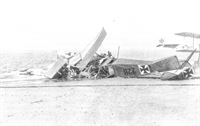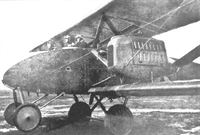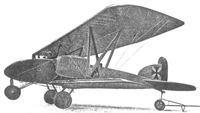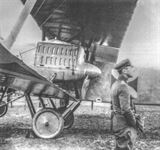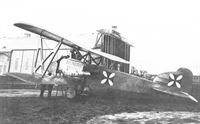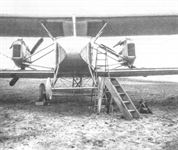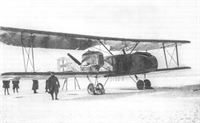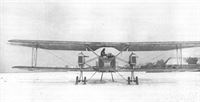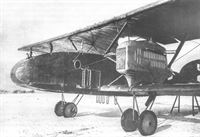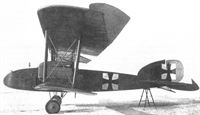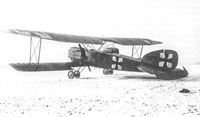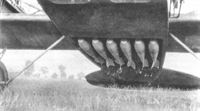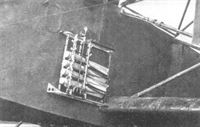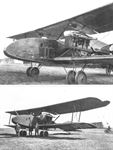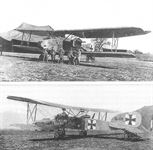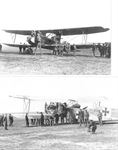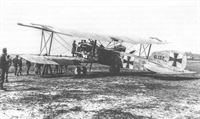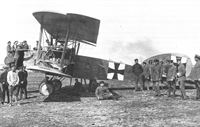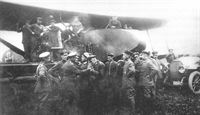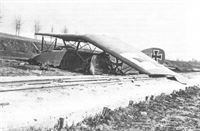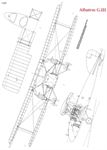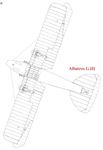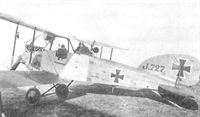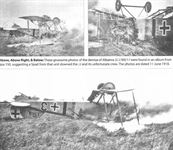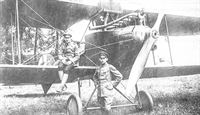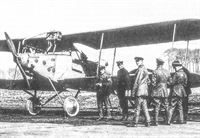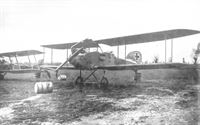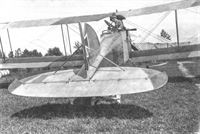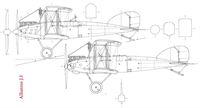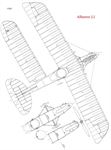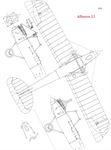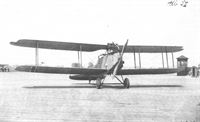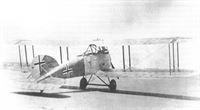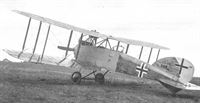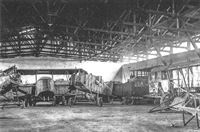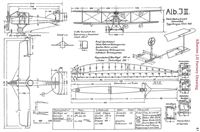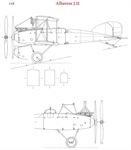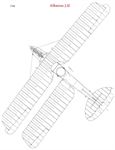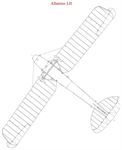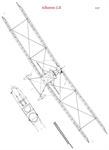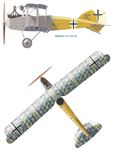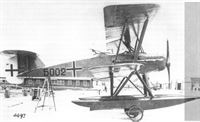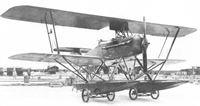Книги
Centennial Perspective
J.Herris
Albatros Aircraft of WWI. Volume 3: Bombers, Seaplanes, J-types
228
J.Herris - Albatros Aircraft of WWI. Volume 3: Bombers, Seaplanes, J-types /Centennial Perspective/ (26)
Albatros WDD & W.1
The Albatros WDD (Wasser Doppeldecker Doppelsitzer; water biplane two-seater) first flew in autumn 1913 and was the naval version of the Albatros biplanes that would be classified as B.I in army service. The WDD was a three-bay biplane with two main floats and a tail float. The first WDD was powered by a 100 hp Argus engine; later versions had the 125 hp Argus or contemporary Mercedes or Benz engines. Early aircraft used brow radiators, but later aircraft used side radiators for cooling.
After some success in the 1913 Bodensee Contest the Navy ordered additional aircraft. These became Marine Numbers 52-56.
MN Type Engine
52 Albatros Benz Bz.III
53 Albatros WDD Mercedes
54 Albatros WDD 200 Argus
55 Albatros WDD Mercedes
56 Albatros WDD Benz Bz.III
Like many early aircraft, the WDD experienced running changes in production with little or no documentation about these changes surviving. These aircraft differed enough that had they been built later, at a time when designations were more formal and precise, they could have been given different designations. Changes in the vertical tail design and rear float were the most obvious of the changes made; other changes included the engine, radiators, and main floats.
The WDD and W.1 are covered here in the same section because the W.1 designation was apparently applied retroactively to several developments of the Albatros WDD. Marine Number 52 is an example. Part of the WDD series noted above, it is shown as a W.1 in various references - painted with Marine Number 552, allegedly to deceive Allied intelligence. The other WDD's in the series also were painted with a '5' preceding their actual Marine Number.
Marine Number 74 was another Albatros seaplane retroactively designated W.1, and others so redesignated are Marine Numbers 111, 221-230, 432, and 446.
Albatros Seaplane Specifications
Type W.1 W.2 W.3 W4 MN747 W4 (948-967) W.5 W.8
Engine 150 hp Benz Bz.III or 160 hp Mercedes D.III 150 hp Benz Bz.III 2x150 hp Benz Bz.III 160 hp Mercedes D.III 160 hp Mercedes D.III 2x150 hp Benz Bz.III 195 hp Benz Bz.IIIb
Span 14.3 m 10.0 m 22.7 m 9.50 m 9.50 m 22.7 m 11.46 m
Length 8.56 m 8.2 m 13.1 m 8.50 m 8.50 m 13.1 m 9.59 m
Wing Area 43.0 m2 31.4 m2 - 31.0 m2 - 100 m2 -
Empty Weight - 935 kg. - 709 kg 784 kg 2,263 kg -
Flying Weight - 1,215 kg - 989 kg 155 km/h 3,665 kg -
Maximum Speed - 176 km/h 133 km/h 155 km/h 160 km/h 133 km/h 150 km/h
Climb to 1,000m - - - - 5.5 min. 20.0 min. 6.5 min.
Climb to 2,000m - - - - 8.5 min. -
Climb to 3,000m - - - - 23 min. - 34 min.
Duration - - - - - 4 hours 3.5 hours
Guns None 1 gun 1 gun 1 gun 2 guns 1 gun 1-2 fixed guns + 1 flexible gun
Albatros W.1-W.8 Seaplane Production
Aircraft Number Built Marine Numbers
Albatros W.1 19 52-56, 74, 111, 221-230, 432, 446
Note: The early Albatros seaplanes are not clearly documented in the SVK tables. The Marine Numbers listed for the W.1 include those originally designated WDD (52-56 & 74) and those potentially W.1 (111, 221-230, 432, 446) with no type specified or specified as K.351 and K.361.
The Albatros WDD (Wasser Doppeldecker Doppelsitzer; water biplane two-seater) first flew in autumn 1913 and was the naval version of the Albatros biplanes that would be classified as B.I in army service. The WDD was a three-bay biplane with two main floats and a tail float. The first WDD was powered by a 100 hp Argus engine; later versions had the 125 hp Argus or contemporary Mercedes or Benz engines. Early aircraft used brow radiators, but later aircraft used side radiators for cooling.
After some success in the 1913 Bodensee Contest the Navy ordered additional aircraft. These became Marine Numbers 52-56.
MN Type Engine
52 Albatros Benz Bz.III
53 Albatros WDD Mercedes
54 Albatros WDD 200 Argus
55 Albatros WDD Mercedes
56 Albatros WDD Benz Bz.III
Like many early aircraft, the WDD experienced running changes in production with little or no documentation about these changes surviving. These aircraft differed enough that had they been built later, at a time when designations were more formal and precise, they could have been given different designations. Changes in the vertical tail design and rear float were the most obvious of the changes made; other changes included the engine, radiators, and main floats.
The WDD and W.1 are covered here in the same section because the W.1 designation was apparently applied retroactively to several developments of the Albatros WDD. Marine Number 52 is an example. Part of the WDD series noted above, it is shown as a W.1 in various references - painted with Marine Number 552, allegedly to deceive Allied intelligence. The other WDD's in the series also were painted with a '5' preceding their actual Marine Number.
Marine Number 74 was another Albatros seaplane retroactively designated W.1, and others so redesignated are Marine Numbers 111, 221-230, 432, and 446.
Albatros Seaplane Specifications
Type W.1 W.2 W.3 W4 MN747 W4 (948-967) W.5 W.8
Engine 150 hp Benz Bz.III or 160 hp Mercedes D.III 150 hp Benz Bz.III 2x150 hp Benz Bz.III 160 hp Mercedes D.III 160 hp Mercedes D.III 2x150 hp Benz Bz.III 195 hp Benz Bz.IIIb
Span 14.3 m 10.0 m 22.7 m 9.50 m 9.50 m 22.7 m 11.46 m
Length 8.56 m 8.2 m 13.1 m 8.50 m 8.50 m 13.1 m 9.59 m
Wing Area 43.0 m2 31.4 m2 - 31.0 m2 - 100 m2 -
Empty Weight - 935 kg. - 709 kg 784 kg 2,263 kg -
Flying Weight - 1,215 kg - 989 kg 155 km/h 3,665 kg -
Maximum Speed - 176 km/h 133 km/h 155 km/h 160 km/h 133 km/h 150 km/h
Climb to 1,000m - - - - 5.5 min. 20.0 min. 6.5 min.
Climb to 2,000m - - - - 8.5 min. -
Climb to 3,000m - - - - 23 min. - 34 min.
Duration - - - - - 4 hours 3.5 hours
Guns None 1 gun 1 gun 1 gun 2 guns 1 gun 1-2 fixed guns + 1 flexible gun
Albatros W.1-W.8 Seaplane Production
Aircraft Number Built Marine Numbers
Albatros W.1 19 52-56, 74, 111, 221-230, 432, 446
Note: The early Albatros seaplanes are not clearly documented in the SVK tables. The Marine Numbers listed for the W.1 include those originally designated WDD (52-56 & 74) and those potentially W.1 (111, 221-230, 432, 446) with no type specified or specified as K.351 and K.361.
Albatros WDD with yet another tail design and small national insignia on the fuselage. Side radiators have replaced the brow radiator used on earlier WDDs.
Albatros W.1 Marine Number 52. WWDs 52-56 were retroactively designated W.1s and their Marine Numbers given a '5' prefix to deceive Allied intelligence. Design of the tail surfaces and floats of the WDD/W.1 were in constant evolution.
Side view of the Albatros WDD flown in the 1913 Bodensee Contest shows the rudder shape more clearly. (Peter M. Grosz Collection/SDTB)
The Albatros WDD that competed in the 1913 Bodensee Contest had a smaller rudder than later aircraft.
Originally known as the Albatros WDD (for Wasser Doppeldecker Doppelsitzer, water biplane two-seater), the WDD and its modifications were retroactively designated Albatros W.1. The WDD first flew in the autumn of 1913.
This photo shows the next evolution of the Albatros WDD design with a revised rudder shape and larger tail float.
This photo shows the next evolution of the Albatros WDD design with a revised rudder shape and larger tail float. The seaplane below carries an early national insignia. (Peter M. Grosz Collection/SDTB)
This Albatros W.1 is seen just after take-off; it has no tail float but does have a leading edge radiator and carries national insignia and a naval pennant. (Peter M. Grosz Collection/SDTB)
This Albatros WDD with enlarged tail surfaces and tail float retains the brow radiator. (Peter M. Grosz Collection/SDTB)
Later production Albatros WDD with side radiators and enlarged tail surfaces with horn-balanced rudder and tail float.
Albatros WDD with side radiators and enlarged tail surfaces and tail float but no horn balance on rudder.
Marine Number 552 is a confusing aircraft. MN552 is identified as a Brandenburg built by Danzig in the list of marine numbers but is actually Albatros W.1 Marine Number 52. The Marine Numbers of Albatros W.1/WDD 52-56 were apparently prefixed with a '5' when painted to confuse Allied intelligence. However that worked, it did serve to confuse the author for a time! The W.1 has a redesigned tail compared to the WDD; the rudder was enlarged and the tail float was eliminated.
Another view of Marine Number 552, identified as a Brandenburg built by Danzig in the list of marine numbers.
This appears to be a front view of W.1 Marine Number 552. It has 3-bays of struts, is in similar pose as the other two photos, and has the navy ID pennants. The gravity tank under the upper wing is also present in all photos.
Albatros W.1 Marine Number 55 was assigned to the Kiel naval air station. It has side radiators and tail float and the main floats are of revised design. The wings have been roughly cropped; likely as a result of a forced landing at sea with the crew chopping off the outer wings to make the aircraft more stable on the water while awaiting rescue. (Peter M. Grosz Collection/SDTB)
Albatros W.1 Marine Number 74 was assigned to the Kiel naval air station. It has side radiators and tail float although the main floats are of revised design. It carries 1918 national insignia on its rudder and a naval pennant. (Peter M. Grosz Collection/SDTB)
Albatros W.1 Marine Number 74 was assigned to the Kiel naval air station. It has side radiators and tail float and the main floats are of original design. It carries 1918 national insignia on its rudder and naval pennants. The engine exhaust manifolds and float design differ from those shown on the facing page on this same aircraft. (Peter M. Grosz Collection/SDTB)
This Albatros W.1 in its hangar has a later design of enlarged vertical tail surfaces without tail float. (Peter M. Bowers Collection/Museum of Flight)
Albatros W.1 Marine Number 228 illustrate the final configuration of the Albatros W.1 with enlarged tail surfaces and no tail float. (Peter M. Grosz Collection/SDTB)
Albatros W.1 Marine Number 229 illustrate the final configuration of the Albatros W.1 with enlarged tail surfaces and no tail float. (Peter M. Grosz Collection/SDTB)
Albatros W.1 Marine Number 229 being brought ashore after a flight. (Peter M. Grosz Collection/SDTB)
Albatros W.1 Marine Number 223 being hoisted out of the water after an accident. (Peter M. Grosz Collection/SDTB)
Albatros W.1 Marine Number 226 appears to be a total loss. Marine Number 512 in the background is a Brandenburg FB. (Peter M. Grosz Collection/SDTB)
Albatros Miscellaneous L-Types
After WWI was over, Albatros, a major aircraft manufacturer in defeated Germany, decided to retroactively introduce a designation system for their aircraft and projects that had nothing to do with military type designations. The result was the Albatros L Designations that were applied arbitrarily. The L designations were neither chronological nor did they link aircraft in a design lineage.
At least two of these aircraft were not given formal military designations, nor were they produced in quantity or used operationally. These two aircraft, the L3 and the L9, are presented here for completeness.
After WWI was over, Albatros, a major aircraft manufacturer in defeated Germany, decided to retroactively introduce a designation system for their aircraft and projects that had nothing to do with military type designations. The result was the Albatros L Designations that were applied arbitrarily. The L designations were neither chronological nor did they link aircraft in a design lineage.
At least two of these aircraft were not given formal military designations, nor were they produced in quantity or used operationally. These two aircraft, the L3 and the L9, are presented here for completeness.
Known as the GDD 100 hp Gnome, the L3 was a small single-seat biplane. It was probably built in 1914 or early 1915 and was powered by a 100 hp Gnome rotary. It was likely intended as a scout (reconnaissance) aircraft; however, the German Army preferred two-seat reconnaissance aircraft. Construction appears to consist of a semi-monocoque plywood fuselage and conventional wood, wire, and fabric wings, all of which was typical of standard Albatros practice. (Peter M. Bowers Collection/Museum of Flight)
The Albatros L9, designed by Dorner, had thick, high-lift wings similar to the later Albatros G.III bomber. The wings were greatly staggered and a small, vulnerable-looking button rudder without fixed fin was used. Power was from a 100 hp Albatros D.I engine with brow radiator mounted over the engine. Directional stability would seem to have been marginal. A single interplane strut was used together with large struts bracing the wing spars. Despite the eccentric configuration, this aircraft may have been an ancestor of the later Albatros fighters. (Peter M. Bowers Collection/Museum of Flight)
One more view of the unusual Albatros L9 are shown here. The interplane struts, which connect the rear spar of the top wing to the front spar of the bottom wing, seem inadequate and may indicate the wings were essentially cantilever designs. The interplane strut improved aileron effectiveness by stiffening the wing cellule.
The sole Albatros G.II prototype under test at Johannisthal. An Albatros C.V is in the background. (Peter M. Grosz Collection/SDTB)
Albatros G.I
Ostdeutsche Albatroswerke G.m.b.H (OAW), part of the Albatroswerke G.m.b.H, was one of two Albatros companies until they merged in October 1917. Chief engineer at OAW was Dipl.- Ing. Karl Grohmann, who designed the Albatros G.I. Only a single Albatros G.I was built at OAW's Schneidemuhl factory. Interestingly, it was a rare, four-engine aircraft with three bays of bracing outboard of the tractor engines. The G.I was powered by four 120 hp Mercedes D.II engines and made its first flight on January 31, 1916, but no further details are available. For unknown reasons the aircraft was unsatisfactory and no further development was undertaken.
Albatros Bomber Specifications
G.I G.II G.III
Engines 4 x 120 hp Mercedes D.II 2 x 150 hp Benz Bz.III 2 x 220 hp Benz Bz.IV
Span (Upper) 30 m 17.0 m 18.0 m
Span (Lower) - 17.0 m 17.0 m
Length - 11.9 m 11.9m
Height - 4.2 m 4.2 m
Empty Weight - - 2,004 kg
Loaded Weight 4,319 kg - 3,086 kg
Max. Speed - - 150 km/h
Climb, 1,000 m - 9.3 minutes 10.0 minutes
Climb, 2,000 m - 25 minutes 30 minutes
Climb, 3,000 m - 70 minutes 45 minutes
Service Ceiling - 3,000 m 3,000 m
Range/Endurance - 4 hours 595 km
Bomb Load - - 325 kg
Armament - 2 flexible MGs 2 flexible MGs
Note: Only one G.I and one G.II were built. The highest number of Albatros bombers at the front was 9, indicating a short production run. Known serials were in the range G.126-132/16.
Ostdeutsche Albatroswerke G.m.b.H (OAW), part of the Albatroswerke G.m.b.H, was one of two Albatros companies until they merged in October 1917. Chief engineer at OAW was Dipl.- Ing. Karl Grohmann, who designed the Albatros G.I. Only a single Albatros G.I was built at OAW's Schneidemuhl factory. Interestingly, it was a rare, four-engine aircraft with three bays of bracing outboard of the tractor engines. The G.I was powered by four 120 hp Mercedes D.II engines and made its first flight on January 31, 1916, but no further details are available. For unknown reasons the aircraft was unsatisfactory and no further development was undertaken.
Albatros Bomber Specifications
G.I G.II G.III
Engines 4 x 120 hp Mercedes D.II 2 x 150 hp Benz Bz.III 2 x 220 hp Benz Bz.IV
Span (Upper) 30 m 17.0 m 18.0 m
Span (Lower) - 17.0 m 17.0 m
Length - 11.9 m 11.9m
Height - 4.2 m 4.2 m
Empty Weight - - 2,004 kg
Loaded Weight 4,319 kg - 3,086 kg
Max. Speed - - 150 km/h
Climb, 1,000 m - 9.3 minutes 10.0 minutes
Climb, 2,000 m - 25 minutes 30 minutes
Climb, 3,000 m - 70 minutes 45 minutes
Service Ceiling - 3,000 m 3,000 m
Range/Endurance - 4 hours 595 km
Bomb Load - - 325 kg
Armament - 2 flexible MGs 2 flexible MGs
Note: Only one G.I and one G.II were built. The highest number of Albatros bombers at the front was 9, indicating a short production run. Known serials were in the range G.126-132/16.
A single Albatros G.I was built but the type was not satisfactory. (Above: Peter M. Grosz Collection, SDTB)
Albatros G.II
At the main Albatros factory at Johannisthal, Robert Thelen, assisted by George Madelung, designed the two-engine Albatros G.II based on the Kampfflugzeug specifications promulgated by Idflieg in July 1914. Madelung was responsible for the thick airfoil section chosen for the G.II that was intended to give it greater lift than the thin sections then common. The prototype C.IV was built specifically to test this thick airfoil section for the G.II.
The G.II fuselage was covered with plywood like other Albatros designs of that time and carried three crewmen, a pilot in the middle and fore and aft gunners. The massive interplane struts eliminated the need for incidence bracing wires and the landing gear resembled that of a two-seater except for the nose gear. With 150 hp Benz Bz.III engines the aircraft was reliable but under-powered, and interest moved on to a more powerful derivative, the G.III.
Albatros G.III
The Albatros G.III was based on the G.II and used a similar, perhaps identical, plywood-covered fuselage. More powerful engines, 220 hp Benz Bz.IV inline six-cylinder types, were fitted to improve climb and bombload. The thick airfoil section was retained, and to further improve load-carrying capability the upper wing span was increased by a meter for more lifting area. At first the ailerons were similar to those of the G.II, but later aerodynamic balances were fitted to reduced the pilot's control forces and improve maneuverability. However, the aerodynamic balance on the rudder was deleted, apparently to harmonize the control forces.
The landing gear was modified to eliminate the nose gear and dual wheels were fitted to each main gear. More conventional interplane bracing was used, although the G.III retained the single-bay configuration. Installation of the more powerful engines was similar to the G.II but the mounting was more streamlined. However, cooling problems must have afflicted the G.III because nearly all photos of operational G.III bombers show them without any cowling panels for improved cooling at the expense of streamlining.
Despite the improvements compared to the G.II, the G.III still had a lighter bomb load than its rivals and its flying and landing characteristics were not as good as desired. Regardless, Idflieg ordered a small number of G.III bombers, perhaps 10-12, for operational evaluation. In early 1917 some were assigned to Kagohl 4 in the Balkans, and others were assigned to Kagohl 2 on the Western Front. The G.III front-line inventory peaked at nine aircraft in April and only one was at the front by the end of 1917.
The Albatros G.III thus made a limited contribution to the German war effort and was the least successful operational bomber. Its qualities were such that Albatros abandoned further development of two-engine bombers to focus on their more successful fighters and two-seaters.
Albatros Bomber Specifications
G.I G.II G.III
Engines 4 x 120 hp Mercedes D.II 2 x 150 hp Benz Bz.III 2 x 220 hp Benz Bz.IV
Span (Upper) 30 m 17.0 m 18.0 m
Span (Lower) - 17.0 m 17.0 m
Length - 11.9 m 11.9m
Height - 4.2 m 4.2 m
Empty Weight - - 2,004 kg
Loaded Weight 4,319 kg - 3,086 kg
Max. Speed - - 150 km/h
Climb, 1,000 m - 9.3 minutes 10.0 minutes
Climb, 2,000 m - 25 minutes 30 minutes
Climb, 3,000 m - 70 minutes 45 minutes
Service Ceiling - 3,000 m 3,000 m
Range/Endurance - 4 hours 595 km
Bomb Load - - 325 kg
Armament - 2 flexible MGs 2 flexible MGs
Note: Only one G.I and one G.II were built. The highest number of Albatros bombers at the front was 9, indicating a short production run. Known serials were in the range G.126-132/16.
At the main Albatros factory at Johannisthal, Robert Thelen, assisted by George Madelung, designed the two-engine Albatros G.II based on the Kampfflugzeug specifications promulgated by Idflieg in July 1914. Madelung was responsible for the thick airfoil section chosen for the G.II that was intended to give it greater lift than the thin sections then common. The prototype C.IV was built specifically to test this thick airfoil section for the G.II.
The G.II fuselage was covered with plywood like other Albatros designs of that time and carried three crewmen, a pilot in the middle and fore and aft gunners. The massive interplane struts eliminated the need for incidence bracing wires and the landing gear resembled that of a two-seater except for the nose gear. With 150 hp Benz Bz.III engines the aircraft was reliable but under-powered, and interest moved on to a more powerful derivative, the G.III.
Albatros G.III
The Albatros G.III was based on the G.II and used a similar, perhaps identical, plywood-covered fuselage. More powerful engines, 220 hp Benz Bz.IV inline six-cylinder types, were fitted to improve climb and bombload. The thick airfoil section was retained, and to further improve load-carrying capability the upper wing span was increased by a meter for more lifting area. At first the ailerons were similar to those of the G.II, but later aerodynamic balances were fitted to reduced the pilot's control forces and improve maneuverability. However, the aerodynamic balance on the rudder was deleted, apparently to harmonize the control forces.
The landing gear was modified to eliminate the nose gear and dual wheels were fitted to each main gear. More conventional interplane bracing was used, although the G.III retained the single-bay configuration. Installation of the more powerful engines was similar to the G.II but the mounting was more streamlined. However, cooling problems must have afflicted the G.III because nearly all photos of operational G.III bombers show them without any cowling panels for improved cooling at the expense of streamlining.
Despite the improvements compared to the G.II, the G.III still had a lighter bomb load than its rivals and its flying and landing characteristics were not as good as desired. Regardless, Idflieg ordered a small number of G.III bombers, perhaps 10-12, for operational evaluation. In early 1917 some were assigned to Kagohl 4 in the Balkans, and others were assigned to Kagohl 2 on the Western Front. The G.III front-line inventory peaked at nine aircraft in April and only one was at the front by the end of 1917.
The Albatros G.III thus made a limited contribution to the German war effort and was the least successful operational bomber. Its qualities were such that Albatros abandoned further development of two-engine bombers to focus on their more successful fighters and two-seaters.
Albatros Bomber Specifications
G.I G.II G.III
Engines 4 x 120 hp Mercedes D.II 2 x 150 hp Benz Bz.III 2 x 220 hp Benz Bz.IV
Span (Upper) 30 m 17.0 m 18.0 m
Span (Lower) - 17.0 m 17.0 m
Length - 11.9 m 11.9m
Height - 4.2 m 4.2 m
Empty Weight - - 2,004 kg
Loaded Weight 4,319 kg - 3,086 kg
Max. Speed - - 150 km/h
Climb, 1,000 m - 9.3 minutes 10.0 minutes
Climb, 2,000 m - 25 minutes 30 minutes
Climb, 3,000 m - 70 minutes 45 minutes
Service Ceiling - 3,000 m 3,000 m
Range/Endurance - 4 hours 595 km
Bomb Load - - 325 kg
Armament - 2 flexible MGs 2 flexible MGs
Note: Only one G.I and one G.II were built. The highest number of Albatros bombers at the front was 9, indicating a short production run. Known serials were in the range G.126-132/16.
The Albatros G.II was powered by 150 hp Benz engines mounted as pushers above the lower wing in streamlined nacelles. Its thick wing section is unusual for the time, as are the interesting interplane struts. The simple undercarriage is designed to prevent nose-overs on soft fields.
AN INTERESTING ENEMY BOMBER. - The Albatros type G. biplane. This machine, it will be noticed, has only one pair of inter-plane struts outside the engine on each side. The formation of these struts is unusual, diagonal struts having, apparently, taken the place of incidence wires. The upper plane appears to be of a very deep section, as in the latest Fokker machines, and it would seem probable that this feature accounts for the small number of inter-plane struts.
AN INTERESTING ENEMY BOMBER. - The Albatros type G. biplane. This machine, it will be noticed, has only one pair of inter-plane struts outside the engine on each side. The formation of these struts is unusual, diagonal struts having, apparently, taken the place of incidence wires. The upper plane appears to be of a very deep section, as in the latest Fokker machines, and it would seem probable that this feature accounts for the small number of inter-plane struts.
More images of the sole Albatros G.II prototype under test at Johannisthal. (Peter M. Grosz Collection/SDTB)
The Albatros G.II was a compact, streamlined bomber with good flying characteristics. However, climb and ceiling were poor and it was evident that more power was needed than the 150 hp Benz Bz.III engines delivered. Design of the G.II was unrelated to the G.I other than company name.
The sole Albatros G.II looked like a member of the Albatros family of aircraft with the exceptions of the thick airfoil and the balanced rudder needed to give more directional control in case of engine failure.
The sole Albatros G.II prototype under test at Johannisthal. Its thick airfoil, equal span wings, and massive single-bay interplane struts were hallmarks of this distinctive design.
The sole Albatros G.II prototype under test at Johannisthal. An Albatros C.V is in the background. (Peter M. Grosz Collection/SDTB)
Albatros G.III, likely the prototype, undergoing winter testing with its engine cowlings fitted. Bomb racks are visible under the center section. (Peter M. Grosz Collection/SDTB)
Albatros G.III bomber, possibly the prototype, undergoing flight testing in wintery conditions with close-fitting radiators. A refinement of the earlier G.II design with several improvements, it still failed to meet the demands of carrying a greater bomb load.
Albatros G.III, likely the prototype, undergoing winter testing with its engine cowlings fitted. The bomb racks are clearly visible on the fuselage sides and under the center section. (Peter M. Grosz Collection/SDTB)
This appears to be the prototype Albatros G.III after the ailerons were fitted with aerodynamic balances to reduce the control forces. The G.III was streamlined for a 1916 two-engine bomber. The thick airfoil section for high lift, unusual for an Albatros design, is clearly evident.
This rear quarter view of the Albatros G.III prototype emphasizes its aerodynamic design for a two-engine bomber of the period. The engines are mounted in streamlined nacelles, the wing bracing is single-bay, and the landing gear is simple. The tail surfaces are shaped like the successful, contemporary Albatros two-seaters and fighters, although the fuselage was rectangular in cross section, unlike Albatros fighters with their oval fuselage designs. The G.III had three crewmen, a pilot and fore and aft gunners, and each gunner had a single, flexible machine gun. The thick airfoil section was chosen for high lift and within Albatros designs was unique to the G.II, G.III, and the C.IV airfoil testbed. Flight testing led to addition of aerodynamic balances on the ailerons to reduce control forces and improve maneuverability. The number of Albatros G.III bombers built is not known; but the maximum front-line inventory was nine in April 1917.
Albatros G.III in dark colors displays its bomb load. Six heavier bombs (in this case apparently 50 kg P.u.W. bombs) are carried under the fuselage near the center of gravity and smaller (12.5 kg P.u.W.) bombs are carried in racks on the fuselage sides. The bomb load could total at least 325 kg, and this G.III appears to be carrying more than that.
Better known for their single engined reconnaissance and fighter types, the Albatros concern did venture into bomber design, but not with the success associated with their lighter machines. The close-up image shows the sole Albatros G II 3-man machine of 1916. This twin 150hp Benz Bz III powered machine led to the generally cleaner and more powerful Albatros G III that used two 220hp Benz Bz IVa engines. Capable of carrying up to 660lb of bombs, the G III had a top level speed of 93.8mph. With the prototype of the G III completed at the end of 1916, only a small number of G IIIs were built and delivered to a section of KG 6 in 1917, the wing, at that time, operating in Macedonia.
Albatros G.III G.126/16 serving with an operational unit. The thick airfoil section is prominent as are the bomb racks. Although the spinners have been retained, the engine cowling has been removed for additional cooling. The wood grain of the ply-covered fuselage is noticeable in the photo above, but appears to have been painted in the photo below, probably for duty as a night bomber because the paint appears as dark as the national insignia under the wing, but lighter on the fuselage, probably as a result of the sunlight.
Albatros G.III G.130/16 Hansi at an operational unit. The thick airfoil section and aerodynamically-balanced ailerons are unlike other contemporary Albatros warplanes, but the shape of the tail surfaces is very similar to that of contemporary Albatros fighters and two-seaters.
Albatros G.III G.132/16 at an operational unit. The thick airfoil section - unlike other contemporary Albatros warplanes - and fuselage bomb racks are prominent. The spinners are missing and the engine cowlings have been removed for improved cooling despite the increased drag produced. Above some nurses are being given a guided tour of the aircraft.
Another photo of Albatros G.III G.132/16 at an operational unit.The spinners are missing and the engine cowlings have been removed for improved cooling despite the increased drag produced.
Albatros G.III G.132/16 at an operational unit is the center of a lot of attention as well as a popular background for group photographs.
Aircrew and visitors relax around an Albatros G.III bomber in the field. Like most photos showing operational G.III bombers, it has had its engine cowlings removed.
Aircrew and others relax around their Albatros G.III bomber with its engine cowlings removed. The fact nearly all photos show the G.III without engine cowlings indicates cooling problems.
Landing accidents with Albatros G.III. The aircraft, likely the prototype, was flying in winter and had its engine cowlings fitted.
Two views of a winter landing accident. The aircraft, likely the prototype, had its engine cowlings fitted. The starboard landing gear was torn from the aircraft during the accident. This appears to be the same aircraft and accident shown in the winter accident scene. (Peter M. Grosz Collection/SDTB)
Albatros G II of Kasta 7, Kagohl II, flown by Leutnant Graf von Guerard with Leutnant Meye as observer, crashed on Neuflize aerodrome near Le Chatelet in April 1917 on return from an operational flight. This aircraft type was produced only in small numbers and from the maximum of nine at the Front, achieved at the end of April, some were also used by Kagohl IV. The magazine rack for the horizontal stowage of six P.u.W. 12.5kg bombs can be seen attached to the fuselage in front of the port bottom wing root. Magazines of this type were also installed internally. Bombs could be dropped individually, six movements of the bomb release being required to empty the rack; each selection released the lowermost bomb, but a salvo selection was also possible so that all the bombs could be released at the same time.
Due to its dark finish this Albatros G.III appears to be from an operational unit and crashed on the railroad tracks, perhaps while attempting an emergency landing. (Peter M. Grosz Collection/SDTB)
Albatros W.2
The Albatros W.2 was a reconnaissance floatplane derived from the C.III airframe. Powered by a 160 hp Mercedes D.III engine, the W.2 had a flexible gun for the observer; unlike the C.III, the pilot did not have a fixed gun. A single W.2, Marine Number 450, was ordered in December 1915 and delivered in June 1916. No further production was undertaken and no details are available.
The W.2 was a clean-looking design derived from a successful land reconnaissance type, so would seem to be a serious candidate for production. Perhaps its simple float undercarriage was not robust enough compared to its Friedrichshafen counterparts.
Albatros Seaplane Specifications
Type W.1 W.2 W.3 W4 MN747 W4 (948-967) W.5 W.8
Engine 150 hp Benz Bz.III or 160 hp Mercedes D.III 150 hp Benz Bz.III 2x150 hp Benz Bz.III 160 hp Mercedes D.III 160 hp Mercedes D.III 2x150 hp Benz Bz.III 195 hp Benz Bz.IIIb
Span 14.3 m 10.0 m 22.7 m 9.50 m 9.50 m 22.7 m 11.46 m
Length 8.56 m 8.2 m 13.1 m 8.50 m 8.50 m 13.1 m 9.59 m
Wing Area 43.0 m2 31.4 m2 - 31.0 m2 - 100 m2 -
Empty Weight - 935 kg. - 709 kg 784 kg 2,263 kg -
Flying Weight - 1,215 kg - 989 kg 155 km/h 3,665 kg -
Maximum Speed - 176 km/h 133 km/h 155 km/h 160 km/h 133 km/h 150 km/h
Climb to 1,000m - - - - 5.5 min. 20.0 min. 6.5 min.
Climb to 2,000m - - - - 8.5 min. -
Climb to 3,000m - - - - 23 min. - 34 min.
Duration - - - - - 4 hours 3.5 hours
Guns None 1 gun 1 gun 1 gun 2 guns 1 gun 1-2 fixed guns + 1 flexible gun
Albatros W.1-W.8 Seaplane Production
Aircraft Number Built Marine Numbers
Albatros W.2 1 450
The Albatros W.2 was a reconnaissance floatplane derived from the C.III airframe. Powered by a 160 hp Mercedes D.III engine, the W.2 had a flexible gun for the observer; unlike the C.III, the pilot did not have a fixed gun. A single W.2, Marine Number 450, was ordered in December 1915 and delivered in June 1916. No further production was undertaken and no details are available.
The W.2 was a clean-looking design derived from a successful land reconnaissance type, so would seem to be a serious candidate for production. Perhaps its simple float undercarriage was not robust enough compared to its Friedrichshafen counterparts.
Albatros Seaplane Specifications
Type W.1 W.2 W.3 W4 MN747 W4 (948-967) W.5 W.8
Engine 150 hp Benz Bz.III or 160 hp Mercedes D.III 150 hp Benz Bz.III 2x150 hp Benz Bz.III 160 hp Mercedes D.III 160 hp Mercedes D.III 2x150 hp Benz Bz.III 195 hp Benz Bz.IIIb
Span 14.3 m 10.0 m 22.7 m 9.50 m 9.50 m 22.7 m 11.46 m
Length 8.56 m 8.2 m 13.1 m 8.50 m 8.50 m 13.1 m 9.59 m
Wing Area 43.0 m2 31.4 m2 - 31.0 m2 - 100 m2 -
Empty Weight - 935 kg. - 709 kg 784 kg 2,263 kg -
Flying Weight - 1,215 kg - 989 kg 155 km/h 3,665 kg -
Maximum Speed - 176 km/h 133 km/h 155 km/h 160 km/h 133 km/h 150 km/h
Climb to 1,000m - - - - 5.5 min. 20.0 min. 6.5 min.
Climb to 2,000m - - - - 8.5 min. -
Climb to 3,000m - - - - 23 min. - 34 min.
Duration - - - - - 4 hours 3.5 hours
Guns None 1 gun 1 gun 1 gun 2 guns 1 gun 1-2 fixed guns + 1 flexible gun
Albatros W.1-W.8 Seaplane Production
Aircraft Number Built Marine Numbers
Albatros W.2 1 450
The sole example of the Albatros W.2 is shown before its Marine Number of 450 was applied. The engine was a 160 hp Mercedes D.III.
The Albatros W.2 was a clean design for a two-seat reconnaissance floatplane. The observer had a single flexible machine gun; there was no fixed gun for the pilot.
Albatros W.3
The Albatros W.3 was ordered in October 1915 and delivered in July 1916. It was the first torpedo bomber built by Albatros and only a single prototype, Marine Number 527, was built.
The W.3 was a twin-engine floatplane with its two 150 hp Benz Bz.III engines mounted as pushers. To improve streamlining the pusher propellers had spinners. The large, boxy radiators were mounted at the top front of the nacelles. The wood structure was typical of Albatros practice of the time and the design had typical Albatros lines. The design provided for a torpedo carried under the fuselage and semi-recessed to reduce drag.
Little is known about the W.3's handling qualities, but the overall design was worthy of development into the very similar Albatros W.5 that was essentially the production version of the W.3 prototype.
Albatros W.5
A batch of five Albatros W.5 torpedo bombers, Marine Numbers 845-849, was ordered in July 1916, the same month the W.3 was delivered. Apparently the priority of the W.5 was fairly low as deliveries of the five aircraft were stretched out from May 1917 to January 1918.
The W.5 was essential a refined derivative of the original W.3 and shared many similarities with the earlier design. Wing span and length of the W.3 and W.5 were the same and both types were powered by two 150 hp Benz Bz.III engines mounted as pushers. Like the W.3, the W.5 had propeller spinners and provision for a single torpedo mounted below the fuselage, although the torpedo recess under the fuselage was larger in the W.5. The radiators and engine nacelles of the W.5 were more refined for lower drag with better cooling. Photos of Marine Number 845 show ailerons on the upper wing only like the W.3, but apparently lateral control needed improvement because Marine Number 847 had ailerons on all four wings connected by an actuating strut. The SVK drawing of the W.5, which indicated it applied to all five Marine Numbers built, show ailerons on all four wings, so that was intended as the standard configuration. It is not known if MN 845 was later modified to have four ailerons or left in its original configuration. The floats of the W.5 were enlarged compared to the W.3.
The small production order is an indication that the W.5's performance was below that of its Gotha and Brandenburg competitors, and the leisurely delivery schedule reflects the low priority given torpedo bombers after the Navy abandoned aerial torpedo attacks due to the vulnerability of the attacking aircraft.
Albatros Seaplane Specifications
Type W.1 W.2 W.3 W4 MN747 W4 (948-967) W.5 W.8
Engine 150 hp Benz Bz.III or 160 hp Mercedes D.III 150 hp Benz Bz.III 2x150 hp Benz Bz.III 160 hp Mercedes D.III 160 hp Mercedes D.III 2x150 hp Benz Bz.III 195 hp Benz Bz.IIIb
Span 14.3 m 10.0 m 22.7 m 9.50 m 9.50 m 22.7 m 11.46 m
Length 8.56 m 8.2 m 13.1 m 8.50 m 8.50 m 13.1 m 9.59 m
Wing Area 43.0 m2 31.4 m2 - 31.0 m2 - 100 m2 -
Empty Weight - 935 kg. - 709 kg 784 kg 2,263 kg -
Flying Weight - 1,215 kg - 989 kg 155 km/h 3,665 kg -
Maximum Speed - 176 km/h 133 km/h 155 km/h 160 km/h 133 km/h 150 km/h
Climb to 1,000m - - - - 5.5 min. 20.0 min. 6.5 min.
Climb to 2,000m - - - - 8.5 min. -
Climb to 3,000m - - - - 23 min. - 34 min.
Duration - - - - - 4 hours 3.5 hours
Guns None 1 gun 1 gun 1 gun 2 guns 1 gun 1-2 fixed guns + 1 flexible gun
Albatros W.1-W.8 Seaplane Production
Aircraft Number Built Marine Numbers
Albatros W.3 1 527
Albatros W.5 5 845-849
The Albatros W.3 was ordered in October 1915 and delivered in July 1916. It was the first torpedo bomber built by Albatros and only a single prototype, Marine Number 527, was built.
The W.3 was a twin-engine floatplane with its two 150 hp Benz Bz.III engines mounted as pushers. To improve streamlining the pusher propellers had spinners. The large, boxy radiators were mounted at the top front of the nacelles. The wood structure was typical of Albatros practice of the time and the design had typical Albatros lines. The design provided for a torpedo carried under the fuselage and semi-recessed to reduce drag.
Little is known about the W.3's handling qualities, but the overall design was worthy of development into the very similar Albatros W.5 that was essentially the production version of the W.3 prototype.
Albatros W.5
A batch of five Albatros W.5 torpedo bombers, Marine Numbers 845-849, was ordered in July 1916, the same month the W.3 was delivered. Apparently the priority of the W.5 was fairly low as deliveries of the five aircraft were stretched out from May 1917 to January 1918.
The W.5 was essential a refined derivative of the original W.3 and shared many similarities with the earlier design. Wing span and length of the W.3 and W.5 were the same and both types were powered by two 150 hp Benz Bz.III engines mounted as pushers. Like the W.3, the W.5 had propeller spinners and provision for a single torpedo mounted below the fuselage, although the torpedo recess under the fuselage was larger in the W.5. The radiators and engine nacelles of the W.5 were more refined for lower drag with better cooling. Photos of Marine Number 845 show ailerons on the upper wing only like the W.3, but apparently lateral control needed improvement because Marine Number 847 had ailerons on all four wings connected by an actuating strut. The SVK drawing of the W.5, which indicated it applied to all five Marine Numbers built, show ailerons on all four wings, so that was intended as the standard configuration. It is not known if MN 845 was later modified to have four ailerons or left in its original configuration. The floats of the W.5 were enlarged compared to the W.3.
The small production order is an indication that the W.5's performance was below that of its Gotha and Brandenburg competitors, and the leisurely delivery schedule reflects the low priority given torpedo bombers after the Navy abandoned aerial torpedo attacks due to the vulnerability of the attacking aircraft.
Albatros Seaplane Specifications
Type W.1 W.2 W.3 W4 MN747 W4 (948-967) W.5 W.8
Engine 150 hp Benz Bz.III or 160 hp Mercedes D.III 150 hp Benz Bz.III 2x150 hp Benz Bz.III 160 hp Mercedes D.III 160 hp Mercedes D.III 2x150 hp Benz Bz.III 195 hp Benz Bz.IIIb
Span 14.3 m 10.0 m 22.7 m 9.50 m 9.50 m 22.7 m 11.46 m
Length 8.56 m 8.2 m 13.1 m 8.50 m 8.50 m 13.1 m 9.59 m
Wing Area 43.0 m2 31.4 m2 - 31.0 m2 - 100 m2 -
Empty Weight - 935 kg. - 709 kg 784 kg 2,263 kg -
Flying Weight - 1,215 kg - 989 kg 155 km/h 3,665 kg -
Maximum Speed - 176 km/h 133 km/h 155 km/h 160 km/h 133 km/h 150 km/h
Climb to 1,000m - - - - 5.5 min. 20.0 min. 6.5 min.
Climb to 2,000m - - - - 8.5 min. -
Climb to 3,000m - - - - 23 min. - 34 min.
Duration - - - - - 4 hours 3.5 hours
Guns None 1 gun 1 gun 1 gun 2 guns 1 gun 1-2 fixed guns + 1 flexible gun
Albatros W.1-W.8 Seaplane Production
Aircraft Number Built Marine Numbers
Albatros W.3 1 527
Albatros W.5 5 845-849
Albatros W.5 Marine #845 was the first W.5 built. It featured ailerons on the upper wings only and its rudder had a rounded trailing edge.
Albatros W.5 Marine #847 was the third W.5 built. It was to the production standard with ailerons on all wings connected by an actuating strut and its rudder had a straight trailing edge.
The completed Albatros W.3 was a clean design with minimal frontal area for a fairly large, twin-engine biplane floatplane. Albatros had learned the importance of streamlining for performance and applied that lesson to the W.3. (Peter M. Grosz Collection, SDTB)
View of the Albatros W.3 under construction at the factory. The W.3 had ailerons on the upper wing only and used typical Albatros wood construction. (Peter M. Bowers Collection, Museum of Flight)
Marine Number 527 was the only Albatros W.3 built. The W.3 was a class TMG, a torpedo bomber armed with two flexible machine guns.
The completed Albatros W.3 was a clean design with minimal frontal area for a fairly large, twin-engine biplane floatplane. Albatros had learned the importance of streamlining for performance and applied that lesson to the W.3. (Peter M. Grosz Collection, SDTB)
This view of Marine Number 845 also shows that ailerons were fitted to the upper wing only on this aircraft. It is not known if this aircraft was later upgraded to the standard four-aileron configuration shown in the SVK drawing.
Marine Number 847 was the third of five W.5 ordered. The photo shows that ailerons were fitted to all four wings, which is consistent with the type's SVK drawing. Four ailerons was intended as the standard configuration. A torpedo has been loaded and the torpedo's nose and fins are visible.
The twin 150hp Benz Bz III powered Albatros W 5 floatplane torpedo bomber came into naval service in May 1917 Capable of 83mph top level speed at sea level, four of these three man biplanes were built, serials 846 to 849, delivery ending in January 1918. The view of the second aircraft, 847, shows the machine's pusher engine configuration and the torpedo stowed, semi-recessed, within the aircraft's belly.
The twin 150hp Benz Bz III powered Albatros W 5 floatplane torpedo bomber came into naval service in May 1917 Capable of 83mph top level speed at sea level, four of these three man biplanes were built, serials 846 to 849, delivery ending in January 1918. The view of the second aircraft, 847, shows the machine's pusher engine configuration and the torpedo stowed, semi-recessed, within the aircraft's belly.
This view of W.5 Marine Number 847 was likely taken at the same time as the photos above because the torpedo fins are still visible below the fuselage. The rudder has a straight trailing edge. (Peter M. Bowers Collection/Museum of Flight)
Front view of a W.5 in the early configuration with ailerons on the upper wing only. No torpedo is being carried. (Peter M. Bowers Collection/Museum of Flight)
Albatros W.4
Albatros, the largest WWI German aircraft manufacturer, responded to the Navy's request for a floatplane fighter with the W.4, a seaplane development of their Albatros D.I fighter that was being built at the same time. Both the W.4 and D.I were powered by the 160 hp Mercedes D.III engine. Due to its floats, the W.4 was heavier than the D.I and needed larger wings for more lift. The horizontal tail was larger to compensate for the larger wings, and flight testing of the prototype revealed tail heaviness. Changing the amount of stagger solved the problem and happily also improved climb rate and top speed. The prototype and initial production W.4s had ear radiators and a single machine gun. The harsh operating environment caused considerable problems with the wood floats and a number of different designs had to be tried both for strength and seaworthiness. Repairs and water-proofing the leading edge and spars of the lower wings were also required after water damage, including delamination of the spars, was discovered. Starting with the second W.4 production batch, two machine guns were fitted.
The arrival of summer weather revealed problems with the ear radiators, which had to be replaced with a new design. Starting with the fifth production batch (1484-1503), airfoil radiators were fitted to reduce drag. To improve maneuverability the last two production batches were fitted with ailerons on all four wings. A total of 118 W.4s were built.
By the time the final production batch was built, the Brandenburg W.12 two-seat floatplane fighter had proved it was more effective in combat than single- seater floatplane fighters and the final production batch of W.4s was delivered directly to storage. Eight W.4s were traded to the Austro-Hungarian Navy in July 1918 in return for Austro-Daimler V-12 engines to power Staaken R-planes. Designated E5 to E12 in Austro-Hungarian service, these saw no combat. By August 1918 only four W.4s were on combat duty on the North Sea and another five were on combat duty in Turkey.
Albatros W.4 Production Summary
Marine Number Qty Notes
747, 785-786 3 Prototypes; 1 gun, ear radiators
902-911 10 1 gun, ear radiators
948-967 20 2 guns, ear radiators
1107-1116 10 2 guns, ear radiators
1302-1326 25 2 guns, ear radiators
1484-1503 20 2 guns, airfoil radiator, 4 ailerons
1504-1513 10 2 guns, airfoil radiator, 4 ailerons
1719-1738 20 As 1504-1513; delivered directly to storage.
A total of 118 W.4 fighters were built in a series of production batches summarized in this table.
Albatros Seaplane Specifications
Type W.1 W.2 W.3 W4 MN747 W4 (948-967) W.5 W.8
Engine 150 hp Benz Bz.III or 160 hp Mercedes D.III 150 hp Benz Bz.III 2x150 hp Benz Bz.III 160 hp Mercedes D.III 160 hp Mercedes D.III 2x150 hp Benz Bz.III 195 hp Benz Bz.IIIb
Span 14.3 m 10.0 m 22.7 m 9.50 m 9.50 m 22.7 m 11.46 m
Length 8.56 m 8.2 m 13.1 m 8.50 m 8.50 m 13.1 m 9.59 m
Wing Area 43.0 m2 31.4 m2 - 31.0 m2 - 100 m2 -
Empty Weight - 935 kg. - 709 kg 784 kg 2,263 kg -
Flying Weight - 1,215 kg - 989 kg 155 km/h 3,665 kg -
Maximum Speed - 176 km/h 133 km/h 155 km/h 160 km/h 133 km/h 150 km/h
Climb to 1,000m - - - - 5.5 min. 20.0 min. 6.5 min.
Climb to 2,000m - - - - 8.5 min. -
Climb to 3,000m - - - - 23 min. - 34 min.
Duration - - - - - 4 hours 3.5 hours
Guns None 1 gun 1 gun 1 gun 2 guns 1 gun 1-2 fixed guns + 1 flexible gun
Albatros, the largest WWI German aircraft manufacturer, responded to the Navy's request for a floatplane fighter with the W.4, a seaplane development of their Albatros D.I fighter that was being built at the same time. Both the W.4 and D.I were powered by the 160 hp Mercedes D.III engine. Due to its floats, the W.4 was heavier than the D.I and needed larger wings for more lift. The horizontal tail was larger to compensate for the larger wings, and flight testing of the prototype revealed tail heaviness. Changing the amount of stagger solved the problem and happily also improved climb rate and top speed. The prototype and initial production W.4s had ear radiators and a single machine gun. The harsh operating environment caused considerable problems with the wood floats and a number of different designs had to be tried both for strength and seaworthiness. Repairs and water-proofing the leading edge and spars of the lower wings were also required after water damage, including delamination of the spars, was discovered. Starting with the second W.4 production batch, two machine guns were fitted.
The arrival of summer weather revealed problems with the ear radiators, which had to be replaced with a new design. Starting with the fifth production batch (1484-1503), airfoil radiators were fitted to reduce drag. To improve maneuverability the last two production batches were fitted with ailerons on all four wings. A total of 118 W.4s were built.
By the time the final production batch was built, the Brandenburg W.12 two-seat floatplane fighter had proved it was more effective in combat than single- seater floatplane fighters and the final production batch of W.4s was delivered directly to storage. Eight W.4s were traded to the Austro-Hungarian Navy in July 1918 in return for Austro-Daimler V-12 engines to power Staaken R-planes. Designated E5 to E12 in Austro-Hungarian service, these saw no combat. By August 1918 only four W.4s were on combat duty on the North Sea and another five were on combat duty in Turkey.
Albatros W.4 Production Summary
Marine Number Qty Notes
747, 785-786 3 Prototypes; 1 gun, ear radiators
902-911 10 1 gun, ear radiators
948-967 20 2 guns, ear radiators
1107-1116 10 2 guns, ear radiators
1302-1326 25 2 guns, ear radiators
1484-1503 20 2 guns, airfoil radiator, 4 ailerons
1504-1513 10 2 guns, airfoil radiator, 4 ailerons
1719-1738 20 As 1504-1513; delivered directly to storage.
A total of 118 W.4 fighters were built in a series of production batches summarized in this table.
Albatros Seaplane Specifications
Type W.1 W.2 W.3 W4 MN747 W4 (948-967) W.5 W.8
Engine 150 hp Benz Bz.III or 160 hp Mercedes D.III 150 hp Benz Bz.III 2x150 hp Benz Bz.III 160 hp Mercedes D.III 160 hp Mercedes D.III 2x150 hp Benz Bz.III 195 hp Benz Bz.IIIb
Span 14.3 m 10.0 m 22.7 m 9.50 m 9.50 m 22.7 m 11.46 m
Length 8.56 m 8.2 m 13.1 m 8.50 m 8.50 m 13.1 m 9.59 m
Wing Area 43.0 m2 31.4 m2 - 31.0 m2 - 100 m2 -
Empty Weight - 935 kg. - 709 kg 784 kg 2,263 kg -
Flying Weight - 1,215 kg - 989 kg 155 km/h 3,665 kg -
Maximum Speed - 176 km/h 133 km/h 155 km/h 160 km/h 133 km/h 150 km/h
Climb to 1,000m - - - - 5.5 min. 20.0 min. 6.5 min.
Climb to 2,000m - - - - 8.5 min. -
Climb to 3,000m - - - - 23 min. - 34 min.
Duration - - - - - 4 hours 3.5 hours
Guns None 1 gun 1 gun 1 gun 2 guns 1 gun 1-2 fixed guns + 1 flexible gun
The prototype Albatros W.4 Marine #747 as built with stained wood fuselage and clear-doped linen flying surfaces. After it was assigned to Zeebrugge it was partly over-painted in camouflage colors.
Albatros W.4 Marine #747 was given a splotchy camouflage pattern (exact pattern and colors unknown) and named Mowe (Seagull) after assignment to Seeflugstation Zeebrugge. It was flown by Oblt.z.S. Friedrich Christiansen.
Albatros W.4 Marine #911 after tactical markings were added. This fighter was flown by Lt.z.S. Schulz, who downed three aircraft while flying it.
Albatros W.4 Marine #1512 illustrates the final W.4 production configuration with two guns, an airfoil radiator, and ailerons on all four wings for better maneuverability, and finished in standard naval late-war camouflage.
This late production Albatros W.4 with unknown Marine Number carried 1918 national insignia. By 1918 the W.4 was used only for training.
Albatros W.4 prototype MN 747 with visiting dignitaries in the background. Behind MN747 the tail of MN749 can be seen at left. MN749 was the Friedrichshafen FF43 that was a competitor for single-seat floatplane fighter orders from the Navy, but only one was built. Despite remaining a single prototype, the FF43 was assigned to Zeebrugge where it scored a victory. (Peter M. Bowers Collection/Museum of Flight)
A pair of Albatros W4 fighters ready for launching; Marine #911, last aircraft of the first production batch, is nearest the camera. W4 #911 later had additional tactical markings added.
Albatros W.4 #956 of the second production batch. The ear radiator is prominent and, located on both sides of the aircraft, partially spoiled the clean aerodynamic lines of the fuselage. This was addressed by using lower-drag airfoil radiators in the last three production batches.
This photo shows a woman in the cockpit of an Albatros W4; the photo seems to have been retouched to include her in 'pin-up' style, perhaps for a postcard. The W4 appears to be Marine #965 shown above; the dent in the spinner appears to be the same.
Albatros W.4 Marine #965, an aircraft of the second production batch, with its pilot. This photo appears to be the one used to create the 'pin-up' photo.
Albatros W.4 MN 1115 of the third production batch carries an arrow as a personal insignia; the pilot looks pleased to be photographed with his fighter.
The Albatros W.4 was developed from the Albatros D.I to fulfil the classification for a single-seat seaplane fighter in 1916. This particular W.4, Nr. 1115 was flown by Erich Kaestner who served eight years as a Marineflieger.
The Albatros W.4 was developed from the Albatros D.I to fulfil the classification for a single-seat seaplane fighter in 1916. This particular W.4, Nr. 1115 was flown by Erich Kaestner who served eight years as a Marineflieger.
Albatros W.4 Marine #1318, from the fourth production batch, is shown here at the Austro-Hungarian Seeflugstation Puntisella in July 1918 before its new Austro-Hungarian serial E12 was applied.
Seeflugzeug 1318, Type Albatros W.4, Seeflugstation Puntisella, Juli 1918, noch mit deutscher Marinenummer, vorgesehen als k.u.k. E 12
Seeflugzeug 1318, Type Albatros W.4, Seeflugstation Puntisella, Juli 1918, noch mit deutscher Marinenummer, vorgesehen als k.u.k. E 12
Albatros W.4 Marine #1322 from the fourth production batch has been damaged by a hard landing. It wears the late insignia so this photo is from 1918, indicating training use. (Peter M. Grosz Collection/SDTB)
W4 #1486 of the fifth production batch before its accident shows the final production configuration of four ailerons, an airfoil radiator, two guns, and the late naval camouflage scheme. (Peter M. Bowers Collection/Museum of Flight)
W.4 MN 1512, sixth production batch, illustrates the final production configuration of four ailerons, an airfoil radiator, and the late naval camouflage scheme. (Peter M. Bowers Collection/Museum of Flight)
W4 #1512, sixth batch, also shows the final production configuration of four ailerons, an airfoil radiator, and the late naval camouflage scheme.
Used essentially for the local air defence of naval seaplane bases in the Flanders area, the single seat Albatros W 4 floatplane fighter entered service with the navy in late 1916. Based on the company's successful D II fighter, but slightly scaled up, the W 4 used a 160hp Mercedes D III, giving it a top level speed of 109mph at 6,560 feet, dropping to 99mph at sea level. Armament comprised a single, synchronized 7.92mm Spandau, although some later machines carried a second gun. In all 117 W 4s were delivered, with 3 in 1916 and 114 in 1917. The machine seen here, serial 1512, was the penultimate of a 10-plane batch delivered during October and November 1917.
Used essentially for the local air defence of naval seaplane bases in the Flanders area, the single seat Albatros W 4 floatplane fighter entered service with the navy in late 1916. Based on the company's successful D II fighter, but slightly scaled up, the W 4 used a 160hp Mercedes D III, giving it a top level speed of 109mph at 6,560 feet, dropping to 99mph at sea level. Armament comprised a single, synchronized 7.92mm Spandau, although some later machines carried a second gun. In all 117 W 4s were delivered, with 3 in 1916 and 114 in 1917. The machine seen here, serial 1512, was the penultimate of a 10-plane batch delivered during October and November 1917.
W.4 MN 1512 illustrates the final production configuration of four ailerons, an airfoil radiator, and the late naval camouflage scheme. (Peter M. Grosz Collection/SDTB)
Oblt.zur See Friedrich Christiansen flying an Albatros W.4. Different float designs are evident in these W.4 photos; many different designs were tried to offer the best combination of handling on the water and in the air while maintaining water-tight integrity in the rough waters. Floats frequently needed replacement on operational aircraft. Christiansen scored 13 victories and was awarded the Pour le Merite.
A crane rescues an Albatros W.4 having a bad day; the naval camouflage fabric is well shown. (Courtesy Bruno Schmaling)
The Albatros J-Types
Albatros was one of three manufacturers that responded to Idflieg's requirement for an armored infantry contact aircraft with their J.I and later J.II. Significantly, the large Albatros firm produced the fewest J-types; moreover, they were the last to reach the front. Given the huge production capacity of Albatros, this is a strong indication that the competing Junkers and AEG J-types were superior to the Albatros J-types. Certainly the Albatros J.I, with its exposed radiator and no engine armor, was the J-type most vulnerable to ground fire, and thus the least successful. Although the Albatros J.II rectified those weaknesses, the wood structure of the Albatros J-types made them more vulnerable to ground fire than the metal Junkers and AEG designs; therefore they were produced in the smallest numbers despite Albatros's production capacity.
Despite its installation in all operational J-types, the Benz B.IV/IVa of 200/220 hp was clearly insufficient for these heavy aircraft. For example, the Albatros J.I was developed from the C.XII and its armor meant it was more than 800 pounds (almost
400 kg) heavier, yet the 260 hp Mercedes in the C.XII was replaced with a 200 hp Benz! Thus the J-types were significantly underpowered even by the modest standards of the time, resulting in long take-off runs, thereby reducing the number of airfields that could be used. Their low power also resulted in low speed, which, together with their higher stall speed due to their heavy armor, provided a relatively small maneuvering speed margin above the stall compared to their unarmored contemporaries. This reduction in their flight envelope made them less forgiving to fly and reduced their safety margin during normal flight operations. Being underpowered also reduced their agility and made them more vulnerable to fighters. Aware of aircrew criticism, in April 1918 Idflieg suggested use of the more powerful 260 hp Mercedes D.IVa engine in J-type aircraft to improve their ability to operate from small fields. Because the Mercedes D.IVa engine was not an overcompressed, high-altitude design, it was suitable for the low-flying J-types, but this upgrade was never implemented during the war.
Albatros J.I
The initial Albatros armored design, the Albatros J.I used the same basic wood wings and tail surfaces as the preceding Albatros C.XII reconnaissance plane. These readily-available components were coupled with a new engine and forward fuselage featuring 5 mm steel sheet armor around the crew cockpits. To maintain center of gravity with the lighter engine, the wings were given 2° of sweepback. In contrast to the airfoil radiator of the Albatros C.XII, the J.I had a box radiator installed in front of the leading edge of the upper wing. To limit weight, the J.I engine cowling and radiator were left unarmored; this led to frequent engine failures due to damage from ground fire.
Like all production J-types, the Albatros J.I used the Benz Bz.IV engine. This 200 hp engine was substantially less powerful than the 260 hp Mercedes D.IVa used in the C.XII from which the J.I was derived. The reduced power, coupled with the increased weight of the armor and increased drag, significantly reduced J.I performance and agility compared to its reconnaissance aircraft predecessors. Initially the Albatros J.I had a very streamlined nose complete with propeller spinner, but this was soon found to be unnecessary for such a slow aircraft and later production aircraft replaced the spinner with a rounded nose, which actually reduced drag.
Initially, the armament consisted of one flexible Parabellum MG 14/17 for the observer. Later, some aircraft were equipped with two LMG 08/15 machine guns fixed in the fuselage floor, which could fire diagonally forward and down at a 45° angle. Furthermore, the crews carried light bombs and grenades, which were thrown by hand to attack troops and other ground targets.
The Albatros J.I was the first German aircraft that deployed a cannon in unrestricted operational service, as distinct from operational trials. In November 1917 the first tests began with the 20 mm Becker cannon, which was installed on the left side of the observer's cockpit of Albatros J.I J.710/17.
After firing 600 rounds in ground tests with the machine's rear fuselage elevated, in-flight firing tests began from the Albatros on 12 December 1917. It was shown that the recoil of the cannon proved substantially less than during the ground tests. Moreover, installation of the cannon hardly affected the in-flight handling characteristics. Target acquisition was deemed good, but the ammunition clip proved difficult to change in the slipstream. By the end of January 1918 testing was successfully completed with the exception of the clip-loading problem. In February this appeared to be solved by provision of a special handgrip on the ammunition clip. Three cannon-armed J.I aircraft were then sent to the front, primarily intended for tank busting, followed by five more in April. Each of these machines had a captured Lewis machine gun installed in the observer's cockpit for defense against fighters; the Lewis was used to save weight.
These eight cannon aircraft underwent combat evaluation with Schlachtstaffeln 10, 17, and 28b during May-June 1918, producing mixed results. Lt. Umlauff, the Idflieg cannon expert who visited various units to demonstrate the new weapon, flew Albatros J.I 734/17 on six missions over the front, but was severely wounded by an enemy fighter while attached to Schlachtstaffel 17. The "expedient" fuselage mounting was criticized because the side location restricted the field of fire, which depended too much on aircraft position and attitude in relation to the target. In addition, it was impossible to repair stoppages aloft. Schlachtstaffel 28b, experiencing problems with stoppages and handling the 15-round magazine, was convinced that a valuable weapon would result from adoption of belt-fed ammunition. Schlachtstaffeln 10 reported no gun stoppages, but noted the ammunition clip did not function smoothly and the side mounting restricted the field of fire. Moreover, accurate aiming was difficult because the tracer and explosive ammunition exhibited different ballistic characteristics. The Schlachtstaffeln expressed the unanimous opinion that the effectiveness of cannon-armed ground-attack aircraft depended wholly on keeping enemy fighters at bay.
Kofl 6 reported that in 12 missions the cannon had proved extremely effective, especially in dawn or dusk attacks on rear-area transportation, and more cannon-armed aircraft were urgently requested. For destroying tanks it was suggested that armor-piercing ammunition be supplied. The recommendation to install the cannon on a pivot mount in the cockpit floor was accepted and tested in at least one Albatros J.I. On 11 June 1918, the first Albatros J.I with a Becker cannon, J.768/17, was forced down in enemy lines by ground fire.
In December 1917, three Albatros J.I without engines were purchased by the k.u.k. Luftfahrtruppe, as Series 09, and received the serial numbers 09.01-09.03. Originally, Albatros J.I 09.01 carried the German Militar-Nummer J.400/17; 90.02 was formerly J.726/17, and 90.03 was formerly J.730/17. Marta-built 250 hp Benz engines were installed. On 28 February 1918, aircraft 09.02 crashed in flames during evaluation tests at Aspern. On 5 May 1918, aircraft 09.01 was damaged at the front and returned to Aspern for repairs. The only J.I used operationally by the Luftfahrtruppe was 09.03, which served with Flik 69/S between July and September 1918.
Albatros J-Type Specifications
Albatros J.I Albatros J.II
Engine 200 hp Benz Bz.IV 220 hp Benz Bz.IVa
Span, Upper 14.14m 14.1m
Span, Lower 13.45m 13.45m
Chord, Upper 1.70m 1.70m
Length 8.83m 8.44m
Track 2.0m 2.0m
Wing Sweepback 2° 1.5°
Wing Area 42.82 m2 43.2 m2
Empty Weight 1,398 kg. 1,515 kg.
Loaded Weight 1,808 kg. 1,927 kg.
Maximum Speed 140 km/h 140 km/h
Climb to 1,000m 11.2 minutes 11.2 minutes
Flight Duration 2.5 hours 2.5 hours
Armament 1 flexible machine gun, some aircraft 2 fixed machine guns 1 flexible machine gun, 2 fixed machine guns
Optional 20mm Becker Cannon 20mm Becker Cannon
Albatros J-Type Production Orders
Serial Numbers Qty Type and Order Date Lowest Known Serial Highest Known Serial
1917 Serials
J.400-424/17 25 Albatros J.I J.400/17 J.424/17
J.700-774/17 75 Albatros J.I J.701/17 J.758/17
1917 Subtotal 100
1918 Serials
J.100-124/18 25 Albatros J.I J.101/18 -
J.125-174/18 50 Albatros J.II ordered Feb. 1918 J.126/18 J.169/18
J.616-715/18 100 Albatros J.II J.616/18 J.714/18
1918 Subtotal 175
- 125 Albatros J.l were ordered and delivered.
- 150 Albatros J.II were ordered and most, perhaps all, were delivered.
Albatros J.I Production Batches
Albatros J.I production orders totaled 125 aircraft in three batches. Review of available photographs appears to show these characteristics:
First Batch of 25, serials J.400-424/17:
Spinners, painted camouflage on top of wings and tail surfaces (like the Albatros C.XII).
Second Batch of 75, serials J.700-774/17:
No spinners, painted camouflage on top of wings and tail surfaces (like the Albatros C.XII).
Third Batch of 25, serials J.100-124/18:
No spinners, printed camouflage fabric on all flying surfaces. Some had patterned camouflage on fuselage.
Note: All Albatros J.II aircraft were apparently finished like late-production J.l aircraft.
Albatros was one of three manufacturers that responded to Idflieg's requirement for an armored infantry contact aircraft with their J.I and later J.II. Significantly, the large Albatros firm produced the fewest J-types; moreover, they were the last to reach the front. Given the huge production capacity of Albatros, this is a strong indication that the competing Junkers and AEG J-types were superior to the Albatros J-types. Certainly the Albatros J.I, with its exposed radiator and no engine armor, was the J-type most vulnerable to ground fire, and thus the least successful. Although the Albatros J.II rectified those weaknesses, the wood structure of the Albatros J-types made them more vulnerable to ground fire than the metal Junkers and AEG designs; therefore they were produced in the smallest numbers despite Albatros's production capacity.
Despite its installation in all operational J-types, the Benz B.IV/IVa of 200/220 hp was clearly insufficient for these heavy aircraft. For example, the Albatros J.I was developed from the C.XII and its armor meant it was more than 800 pounds (almost
400 kg) heavier, yet the 260 hp Mercedes in the C.XII was replaced with a 200 hp Benz! Thus the J-types were significantly underpowered even by the modest standards of the time, resulting in long take-off runs, thereby reducing the number of airfields that could be used. Their low power also resulted in low speed, which, together with their higher stall speed due to their heavy armor, provided a relatively small maneuvering speed margin above the stall compared to their unarmored contemporaries. This reduction in their flight envelope made them less forgiving to fly and reduced their safety margin during normal flight operations. Being underpowered also reduced their agility and made them more vulnerable to fighters. Aware of aircrew criticism, in April 1918 Idflieg suggested use of the more powerful 260 hp Mercedes D.IVa engine in J-type aircraft to improve their ability to operate from small fields. Because the Mercedes D.IVa engine was not an overcompressed, high-altitude design, it was suitable for the low-flying J-types, but this upgrade was never implemented during the war.
Albatros J.I
The initial Albatros armored design, the Albatros J.I used the same basic wood wings and tail surfaces as the preceding Albatros C.XII reconnaissance plane. These readily-available components were coupled with a new engine and forward fuselage featuring 5 mm steel sheet armor around the crew cockpits. To maintain center of gravity with the lighter engine, the wings were given 2° of sweepback. In contrast to the airfoil radiator of the Albatros C.XII, the J.I had a box radiator installed in front of the leading edge of the upper wing. To limit weight, the J.I engine cowling and radiator were left unarmored; this led to frequent engine failures due to damage from ground fire.
Like all production J-types, the Albatros J.I used the Benz Bz.IV engine. This 200 hp engine was substantially less powerful than the 260 hp Mercedes D.IVa used in the C.XII from which the J.I was derived. The reduced power, coupled with the increased weight of the armor and increased drag, significantly reduced J.I performance and agility compared to its reconnaissance aircraft predecessors. Initially the Albatros J.I had a very streamlined nose complete with propeller spinner, but this was soon found to be unnecessary for such a slow aircraft and later production aircraft replaced the spinner with a rounded nose, which actually reduced drag.
Initially, the armament consisted of one flexible Parabellum MG 14/17 for the observer. Later, some aircraft were equipped with two LMG 08/15 machine guns fixed in the fuselage floor, which could fire diagonally forward and down at a 45° angle. Furthermore, the crews carried light bombs and grenades, which were thrown by hand to attack troops and other ground targets.
The Albatros J.I was the first German aircraft that deployed a cannon in unrestricted operational service, as distinct from operational trials. In November 1917 the first tests began with the 20 mm Becker cannon, which was installed on the left side of the observer's cockpit of Albatros J.I J.710/17.
After firing 600 rounds in ground tests with the machine's rear fuselage elevated, in-flight firing tests began from the Albatros on 12 December 1917. It was shown that the recoil of the cannon proved substantially less than during the ground tests. Moreover, installation of the cannon hardly affected the in-flight handling characteristics. Target acquisition was deemed good, but the ammunition clip proved difficult to change in the slipstream. By the end of January 1918 testing was successfully completed with the exception of the clip-loading problem. In February this appeared to be solved by provision of a special handgrip on the ammunition clip. Three cannon-armed J.I aircraft were then sent to the front, primarily intended for tank busting, followed by five more in April. Each of these machines had a captured Lewis machine gun installed in the observer's cockpit for defense against fighters; the Lewis was used to save weight.
These eight cannon aircraft underwent combat evaluation with Schlachtstaffeln 10, 17, and 28b during May-June 1918, producing mixed results. Lt. Umlauff, the Idflieg cannon expert who visited various units to demonstrate the new weapon, flew Albatros J.I 734/17 on six missions over the front, but was severely wounded by an enemy fighter while attached to Schlachtstaffel 17. The "expedient" fuselage mounting was criticized because the side location restricted the field of fire, which depended too much on aircraft position and attitude in relation to the target. In addition, it was impossible to repair stoppages aloft. Schlachtstaffel 28b, experiencing problems with stoppages and handling the 15-round magazine, was convinced that a valuable weapon would result from adoption of belt-fed ammunition. Schlachtstaffeln 10 reported no gun stoppages, but noted the ammunition clip did not function smoothly and the side mounting restricted the field of fire. Moreover, accurate aiming was difficult because the tracer and explosive ammunition exhibited different ballistic characteristics. The Schlachtstaffeln expressed the unanimous opinion that the effectiveness of cannon-armed ground-attack aircraft depended wholly on keeping enemy fighters at bay.
Kofl 6 reported that in 12 missions the cannon had proved extremely effective, especially in dawn or dusk attacks on rear-area transportation, and more cannon-armed aircraft were urgently requested. For destroying tanks it was suggested that armor-piercing ammunition be supplied. The recommendation to install the cannon on a pivot mount in the cockpit floor was accepted and tested in at least one Albatros J.I. On 11 June 1918, the first Albatros J.I with a Becker cannon, J.768/17, was forced down in enemy lines by ground fire.
In December 1917, three Albatros J.I without engines were purchased by the k.u.k. Luftfahrtruppe, as Series 09, and received the serial numbers 09.01-09.03. Originally, Albatros J.I 09.01 carried the German Militar-Nummer J.400/17; 90.02 was formerly J.726/17, and 90.03 was formerly J.730/17. Marta-built 250 hp Benz engines were installed. On 28 February 1918, aircraft 09.02 crashed in flames during evaluation tests at Aspern. On 5 May 1918, aircraft 09.01 was damaged at the front and returned to Aspern for repairs. The only J.I used operationally by the Luftfahrtruppe was 09.03, which served with Flik 69/S between July and September 1918.
Albatros J-Type Specifications
Albatros J.I Albatros J.II
Engine 200 hp Benz Bz.IV 220 hp Benz Bz.IVa
Span, Upper 14.14m 14.1m
Span, Lower 13.45m 13.45m
Chord, Upper 1.70m 1.70m
Length 8.83m 8.44m
Track 2.0m 2.0m
Wing Sweepback 2° 1.5°
Wing Area 42.82 m2 43.2 m2
Empty Weight 1,398 kg. 1,515 kg.
Loaded Weight 1,808 kg. 1,927 kg.
Maximum Speed 140 km/h 140 km/h
Climb to 1,000m 11.2 minutes 11.2 minutes
Flight Duration 2.5 hours 2.5 hours
Armament 1 flexible machine gun, some aircraft 2 fixed machine guns 1 flexible machine gun, 2 fixed machine guns
Optional 20mm Becker Cannon 20mm Becker Cannon
Albatros J-Type Production Orders
Serial Numbers Qty Type and Order Date Lowest Known Serial Highest Known Serial
1917 Serials
J.400-424/17 25 Albatros J.I J.400/17 J.424/17
J.700-774/17 75 Albatros J.I J.701/17 J.758/17
1917 Subtotal 100
1918 Serials
J.100-124/18 25 Albatros J.I J.101/18 -
J.125-174/18 50 Albatros J.II ordered Feb. 1918 J.126/18 J.169/18
J.616-715/18 100 Albatros J.II J.616/18 J.714/18
1918 Subtotal 175
- 125 Albatros J.l were ordered and delivered.
- 150 Albatros J.II were ordered and most, perhaps all, were delivered.
Albatros J.I Production Batches
Albatros J.I production orders totaled 125 aircraft in three batches. Review of available photographs appears to show these characteristics:
First Batch of 25, serials J.400-424/17:
Spinners, painted camouflage on top of wings and tail surfaces (like the Albatros C.XII).
Second Batch of 75, serials J.700-774/17:
No spinners, painted camouflage on top of wings and tail surfaces (like the Albatros C.XII).
Third Batch of 25, serials J.100-124/18:
No spinners, printed camouflage fabric on all flying surfaces. Some had patterned camouflage on fuselage.
Note: All Albatros J.II aircraft were apparently finished like late-production J.l aircraft.
Albatros J.I J.415/17 Number "VI" of Flieger-Abteilung (A) 238. Patches covering bullet holes have been painted as cockades.
Albatros J.I J.424/17, previously photographed in 1917 insignia in the markings of an unknown unit, was later seen in summer 1918 markings.
Albatros J.I J.401/17 at Adlershof.The J.I used the wings and tail of the Albatros C.XII fitted to its armored fuselage. The fuselage behind the armor was wood like the Albatros C-types. The wireless antenna lead is hanging below the observer's cockpit.
An early production Albatros J.I, perhaps J.401/17, showing the propeller spinner used on the early machines.
Albatros J.I J.401/17, the second production aircraft, is shown at Adlershof undergoing evaluation.The nose has a spinner and streamlined shape because there was no armor around the engine. The Albatros J.I was the only J-type without engine armor and was therefore the aircraft most vulnerable to ground-fire of all the J-types.
Albatros J.I J.402/17, the third production aircraft, is shown after a bad landing in December 1917. The J.I used the wings and tail surfaces of the C.XII but the fuselage was far less elegant. Early aircraft had a propeller spinner; that was soon abandoned as unnecessary for such a slow aircraft.
An early production Albatros J.I with spinner, probably J.411/17, in 1918 insignia. (Peter M. Grosz Collection/SDTB)
Two views of an early-production Albatros J.I with propeller spinner; unfortunately, the aircraft is not identified but may be J.411/17.
Albatros J.I J.415/17 with factory finish and Flieger-Abteilung (A) 238 unit markings. The early J.I aircraft used the wing and tailplane camouflage of the late Albatros C-types like the C.XII together with varnished wood rear fuselage and light-gray armor. Over this J.415/17 has black and white elevator stripes, white stripes over the upper wing, and a white field on the upper fuselage behind the gunner with a Roman numeral painted on it, in this case 'VI', which were the Flieger-Abteilung (A) 238 unit markings.
Albatros J.I J.415/17 with factory finish and Flieger-Abteilung (A) 238 unit markings. The closeup view shows the armored door to the pilot's cockpit open.
Albatros J.I J.421/17 serving with FA(A) 293; the older style iron cross has been removed and the new style straight cross painted forward. The spinner and painted upper wing camouflage are first production batch features.
Albatros J.I J.424/17 was the last aircraft of the first production batch. Here it has been repainted in 1918 insignia. Some of the engine cowling panels have been removed, possibly for maintenance, and it still retains its spinner. (Peter M. Grosz Collection/SDTB)
Albatros J.I J.424/17 after a bad landing. It carries a dark, probably black, zig-zag marking on the rear fuselage and a stylized tactical number '7'.
Early production Albatros J.I with spinner, perhaps at Adlershof. Wind tunnel investigations eventually revealed that eliminating the spinner and rounding the nose actually reduced drag, and subsequent production J.I aircraft had no spinner. The same change was made to more well-known aircraft like the Rumpler C.IV and late-production Albatros D.III fighters built in Austria-Hungary.
This view of an early-production Albatros J.I shows the upper surface camouflage pattern. (Peter M. Grosz Collection/SDTB)
Albatros J.I J.706/17 is from the second production batch. In addition to the factory finish it carries a dark, probably black, zig-zag marking on the rear fuselage and tactical number '9'.
The Albatros J.I was developed from the earlier Albatros C.XII by adding armor to the cockpit and replacing the 260 hp Mercedes D.IVa with the 200 hp Benz Bz.IV. The reduced power and great weight greatly reduced performance and flying qualities, but the airplanes depended on their armor for protection. Later two machine guns firing downward at 45° were fitted in addition to the observer's flexible guns.
The Albatros J.I was developed from the earlier Albatros C.XII by adding armor to the cockpit and replacing the 260 hp Mercedes D.IVa with the 200 hp Benz Bz.IV. The reduced power and great weight greatly reduced performance and flying qualities, but the airplanes depended on their armor for protection. Later two machine guns firing downward at 45° were fitted in addition to the observer's flexible guns.
Albatros J.I J.711/17 provides a background for this photograph of members of FliegerAbteilung (A) 257.
Albatros J.I J.714/17 of the second production batch in original 1917 insignia. (Peter M. Grosz Collection/SDTB)
Albatros J.I J.714/17 of the second production batch after a bad landing. J.714/17 is in factory finish with no special markings. The light gray armor around the cockpit is notable and the door providing easier access for the pilot is hanging open. The tubular container under the starboard lower wing is interesting. (AL0613-010 & AL0613-012)
Albatros J.I J.738/17 of the second production batch has two-color camouflage over all upper surfaces and a white V identification marking. (Courtesy Reinhard Zankl)
Albatros J.I J.742/17 of the second production batch crashed in 1918. A white "X" was the identifying marking just forward of the fuselage national insignia.
Albatros J.I J.745/17 of the second production batch has lasted long enough in service to be repainted with 1918 insignia. A dark band is painted around the fuselage and a recognition streamer is attached to the wing. The white background for the tail insignia extends onto the fin. (Peter M. Grosz Collection/SDTB)
Albatros J.I J.758/17 is shown with crew in this excellent portrait. Did 'Teddy' (rear inboard strut) fly any missions?
Colorized photo of Albatros J.I J.758/17 with crew in this excellent portrait courtesy of Jim Miller.
These gruesome photos of the demise of Albatros J.I J.769/17 were found in an album from Spa 150, suggesting a Spad from that unit downed the J.I and its unfortunate crew.The photos are dated 11 June 1918.
This Albatros J.I may be from the second production batch; it has no spinner but does not appear to have printed camouflage fabric. It has been painted overall dark camouflage colors, probably green and lilac like other Albatros two-seaters, with white nose, nose stripe, and letter 'L' probably at Flieger-Abteilung (A) 233 where it was serving when photographed.
Albatros J.I J.400/17 was sold to Austria-Hungary and became 09.01. Here it is ready for transport and may be on its way to Austria because the spinner has been removed and 09.01 had no spinner.
Albatros J.I 09.01 (J.400/17) shortly after its arrival at Aspern in February 1918. Unlike later German J types, the armor plate protected only the crew members, not the engine.
Albatros J.I 09.01 was formerly German Militar-Nummer J.400/17. Marta-built 250 hp Benz engines were installed. On 5 May 1918 Albatros J.I 09.01 was damaged at the front before seeing operations and returned to Aspern for repairs. It no longer has its 'as-built' propeller spinner.
Albatros J.I - "Infanterieflugzeug", Flugzeugnummer 09.01. Die Albatros-Flugzeuge wurden 1918 aus Deutschland angekauft (orig. J 400/17)
Albatros J.I - «Пехотный самолет», номер 09.01. Самолеты Albatros были куплены в Германии в 1918 г. (ориг. J 400/17).
Albatros J.I 09.01 was formerly German Militar-Nummer J.400/17. Marta-built 250 hp Benz engines were installed. On 5 May 1918 Albatros J.I 09.01 was damaged at the front before seeing operations and returned to Aspern for repairs. It no longer has its 'as-built' propeller spinner.
Albatros J.I - "Infanterieflugzeug", Flugzeugnummer 09.01. Die Albatros-Flugzeuge wurden 1918 aus Deutschland angekauft (orig. J 400/17)
Albatros J.I - «Пехотный самолет», номер 09.01. Самолеты Albatros были куплены в Германии в 1918 г. (ориг. J 400/17).
Albatros J.I 09.01 was formerly German Militar-Nummer J.400/17. A Brandenburg C.I is in the background. (AL0613-002)
Albatros J.I 09.03 was the last of three purchased by Austria-Hungary. Formerly J.730/17, 09.03 was the only J.I used operationally by the Luftfahrtruppe; it served with Flik 69/S between July and September 1918. The two-color camouflage painted on the upper surface of the wings and tailplane is evident below.
From July to September 1918, Albatros J.I 09.03 (J.730/17, w/n 4313) was flown by Flik 69/S based at Gajarine, Piave Front. The barely-visible crew members appear to be well-protected by the 5mm armor plate.
From July to September 1918, Albatros J.I 09.03 (J.730/17, w/n 4313) was flown by Flik 69/S based at Gajarine, Piave Front. The barely-visible crew members appear to be well-protected by the 5mm armor plate.
Post-war the new Polish state used a number of German warplanes, including the Albatros J.I. As can be seen on its fin, this J.I, named Smok and with tactical number '6', wears the irregular camouflage pattern illustrated by the Japanese artist in color.
Polish Albatros J.I tactical number '6', apparently before it was named. The photo above shows the irregular camouflage pattern on its fuselage. The photo below is too dark to show the pattern clearly but does show the printed camouflage fabric on the wings and horizontal tail surfaces. The serial, J.I 217/18, does not correspond to known serial numbers for the Albatros J.I.
Closeup of an Albatros J.I radiator reveals that it was not armored. Together with its totally exposed location, that made it especially vulnerable to ground-fire. Engine failure could be expected two-three minutes after radiator puncture. Use of a box radiator instead of an airfoil radiator like that of the C.XII did nothing to improve performance of the J.I.
Closeup of an Albatros J.I showing details of the armor, the wood rear fuselage, and the gunner with his flexible machine gun. The J.I had little of the grace of the elegant Albatros C.XII from which it was derived.
This Albatros J.I, tactical letter 'H', has experienced a bad landing. Downward-firing guns were installed.
As war reparations several German aircraft were sent to Japan, where a contemporary artist painted details of their camouflage, which are reproduced here for the J.I.
Albatros J.I J.415/17 Number "VI" of Flieger-Abteilung (A) 238. Patches covering bullet holes have been painted as cockades.
Albatros J.II
Although the Albatros J.I met the letter of the J-type requirement for armor protection of the crew, it was the only production J-type that did not have an armored engine. Unsurprisingly, lack of engine armor was the flyers' main complaint about the Albatros J.I, leading directly to the redesigned J.II. Like the competing Junkers and AEG designs, the Albatros J.II featured armor around the engine, giving the J.II a boxy nose instead of the streamlined nose of the Albatros J.I. In addition, the radiator was likewise armored to make it less vulnerable.
To compensate for the additional weight of the engine armor, the J.II had the 220 hp Benz Bz.IVa, a slightly more powerful version of the 200 hp Benz Bz.IV engine installed in the J.I. Wing sweep was reduced slightly to maintain proper center of gravity with the additional nose armor. Despite the additional power, maximum speed of the J.II remained the same as the J.I due to the increase in weight and drag - a slow 140 km/h. Like the preceding Albatros J.I, climb and ceiling of the J.II remained modest. Nevertheless, since most missions were flown at 500 meters or less, climb rate and ceiling were not viewed as critical for J-type aircraft, which relied on their armor for protection instead of speed and altitude performance.
Like the preceding C.XII and J.I, the J.II had ailerons on all four wings. However, to reduce control forces and improve responsiveness, the upper wings of the J.II were given horn-balanced ailerons. Tail surfaces remained the same as the J.I. Initially, armament was also the same; a flexible machine gun for the observer and two fixed machine guns firing downward at a 45° angle. However, the Albatros J.II was designed to carry a flexible 20mm Becker cannon mounted in the floor of the observer's cockpit. But Idflieg reported that, by the end of September 1918, no J.II aircraft carrying this armament had been delivered. Forward-firing armament had not been installed on J-type aircraft because it was not considered useful for air-to-air combat given the heavy J-type's lack of agility. Likewise, diving at ground targets for strafing was at first considered too risky for these heavy, armored aircraft. However, due to difficulty aiming the downward-firing guns, as J.II production progressed the two fixed guns reportedly were moved to the conventional position in front of the pilot and firing directly ahead. If so, it was the only J-type to use this armament configuration. Unfortunately, photographs to confirm this installation have not surfaced.
While the Albatros J.II had better armor protection than the J.I, its greater weight with essentially the same wing further increased its stall speed and aggravated the take-off distance, agility, and flight safety challenges suffered by all J-types. Albatros J.II production orders totaled 150 aircraft.
Albatros J-Type Specifications
Albatros J.I Albatros J.II
Engine 200 hp Benz Bz.IV 220 hp Benz Bz.IVa
Span, Upper 14.14m 14.1m
Span, Lower 13.45m 13.45m
Chord, Upper 1.70m 1.70m
Length 8.83m 8.44m
Track 2.0m 2.0m
Wing Sweepback 2° 1.5°
Wing Area 42.82 m2 43.2 m2
Empty Weight 1,398 kg. 1,515 kg.
Loaded Weight 1,808 kg. 1,927 kg.
Maximum Speed 140 km/h 140 km/h
Climb to 1,000m 11.2 minutes 11.2 minutes
Flight Duration 2.5 hours 2.5 hours
Armament 1 flexible machine gun, some aircraft 2 fixed machine guns 1 flexible machine gun, 2 fixed machine guns
Optional 20mm Becker Cannon 20mm Becker Cannon
Albatros J-Type Production Orders
Serial Numbers Qty Type and Order Date Lowest Known Serial Highest Known Serial
1918 Serials
J.125-174/18 50 Albatros J.II ordered Feb. 1918 J.126/18 J.169/18
J.616-715/18 100 Albatros J.II J.616/18 J.714/18
- 150 Albatros J.II were ordered and most, perhaps all, were delivered.
Although the Albatros J.I met the letter of the J-type requirement for armor protection of the crew, it was the only production J-type that did not have an armored engine. Unsurprisingly, lack of engine armor was the flyers' main complaint about the Albatros J.I, leading directly to the redesigned J.II. Like the competing Junkers and AEG designs, the Albatros J.II featured armor around the engine, giving the J.II a boxy nose instead of the streamlined nose of the Albatros J.I. In addition, the radiator was likewise armored to make it less vulnerable.
To compensate for the additional weight of the engine armor, the J.II had the 220 hp Benz Bz.IVa, a slightly more powerful version of the 200 hp Benz Bz.IV engine installed in the J.I. Wing sweep was reduced slightly to maintain proper center of gravity with the additional nose armor. Despite the additional power, maximum speed of the J.II remained the same as the J.I due to the increase in weight and drag - a slow 140 km/h. Like the preceding Albatros J.I, climb and ceiling of the J.II remained modest. Nevertheless, since most missions were flown at 500 meters or less, climb rate and ceiling were not viewed as critical for J-type aircraft, which relied on their armor for protection instead of speed and altitude performance.
Like the preceding C.XII and J.I, the J.II had ailerons on all four wings. However, to reduce control forces and improve responsiveness, the upper wings of the J.II were given horn-balanced ailerons. Tail surfaces remained the same as the J.I. Initially, armament was also the same; a flexible machine gun for the observer and two fixed machine guns firing downward at a 45° angle. However, the Albatros J.II was designed to carry a flexible 20mm Becker cannon mounted in the floor of the observer's cockpit. But Idflieg reported that, by the end of September 1918, no J.II aircraft carrying this armament had been delivered. Forward-firing armament had not been installed on J-type aircraft because it was not considered useful for air-to-air combat given the heavy J-type's lack of agility. Likewise, diving at ground targets for strafing was at first considered too risky for these heavy, armored aircraft. However, due to difficulty aiming the downward-firing guns, as J.II production progressed the two fixed guns reportedly were moved to the conventional position in front of the pilot and firing directly ahead. If so, it was the only J-type to use this armament configuration. Unfortunately, photographs to confirm this installation have not surfaced.
While the Albatros J.II had better armor protection than the J.I, its greater weight with essentially the same wing further increased its stall speed and aggravated the take-off distance, agility, and flight safety challenges suffered by all J-types. Albatros J.II production orders totaled 150 aircraft.
Albatros J-Type Specifications
Albatros J.I Albatros J.II
Engine 200 hp Benz Bz.IV 220 hp Benz Bz.IVa
Span, Upper 14.14m 14.1m
Span, Lower 13.45m 13.45m
Chord, Upper 1.70m 1.70m
Length 8.83m 8.44m
Track 2.0m 2.0m
Wing Sweepback 2° 1.5°
Wing Area 42.82 m2 43.2 m2
Empty Weight 1,398 kg. 1,515 kg.
Loaded Weight 1,808 kg. 1,927 kg.
Maximum Speed 140 km/h 140 km/h
Climb to 1,000m 11.2 minutes 11.2 minutes
Flight Duration 2.5 hours 2.5 hours
Armament 1 flexible machine gun, some aircraft 2 fixed machine guns 1 flexible machine gun, 2 fixed machine guns
Optional 20mm Becker Cannon 20mm Becker Cannon
Albatros J-Type Production Orders
Serial Numbers Qty Type and Order Date Lowest Known Serial Highest Known Serial
1918 Serials
J.125-174/18 50 Albatros J.II ordered Feb. 1918 J.126/18 J.169/18
J.616-715/18 100 Albatros J.II J.616/18 J.714/18
- 150 Albatros J.II were ordered and most, perhaps all, were delivered.
Albatros J.II J.126/18. This aircraft was photographed either with no exhaust or the exhaust was angled downward.
Albatros J.II, serial unknown, in late-war irregular camouflage pattern. This particular pattern was illustrated in drawings made of tribute aircraft sent to Japan in 1919.
The Albatros J.II was redesigned to improve survivability in the hostile environment in which it flew its missions. Most importantly, the entire engine was now armored, solving the worst problem with the J.I. In addition, unlike the J.I, the radiator was now armored, further improving survivability. Finally, the upper ailerons were given aerodynamic horn balances to reduce control pressures for better maneuverability. The same basic Benz engine was used, but power was boosted 10% to 220 hp to compensate for the greater weight of the engine armor, which accounted for the boxy cowling. The result was a more robust, survivable aircraft with essentially the same performance despite its greater weight.
Albatros J.II at the factory, perhaps 127/18. Despite its boxy shape due to construction from armored plates, care has been taken to minimize frontal area to keep drag in check. Two fixed guns firing downward protrude from the bottom of the fuselage. A guard shack painted in stripes is in the right background and the airship hangar is behind the aircraft.
Another view of the same Albatros J.II shows more of its nose. With its armored engine and radiator, the J.II was much more likely to survive being hit by rifle-caliber ground fire than its J.I predecessor.
Some Albatros J.II aircraft had the fuselage camouflage seen on some J.I aircraft and illustrated in color by the Japanese artist. No unit or personal markings are visible; the tires are missing due to the rubber shortage.
Albatros J.II ready for a mission clearly showing the downward-firing guns and observer's flexible gun. The wind-driven dynamo for the wireless is on the front undercarriage strut, and the leads for the antenna are below the fuselage.
Albatros J.II 140/18 serves in basic factory finish and markings; no unit or personal markings are visible.
This rearview of the Albatros J.II displays its standard factory finish and markings. Printed camouflage fabric covers all flying surfaces, the armor is painted light gray, and the wood rear fuselage and fin are varnished.
Albatros J.II 127/18 is shown here in its basic factory finish and markings. Flying surfaces are covered with printed camouflage fabric, the armor is painted light gray, and the wood rear fuselage and fin are clear-varnished.
Albatros J.II 126/18 serves in basic factory finish and markings; no unit or personal markings are visible.
This postwar view of German aircraft sent to Italy as reparations shows an Albatros J.II in the middle with the same pattern of fuselage camouflage seen above, another indication it was applied at the factory.
The 20mm Becker cannons fitted to the Albatros J.Is proved to be effective anti-tank weapons, and 20 Albatros J.II aircraft were fitted with these weapons in an improved mount in the floor of the gunner's cockpit shown here; the front of the aircraft is at the top of the photo. Extra magazines for the Becker are stacked on the sides of the armored cockpit and extra drums of machine gun ammunition are stored at the rear. Twenty AEG J.II aircraft were delivered with a similar Becker installation.
Albatros J.II after a landing accident; the downward-firing guns are barely visible under the fuselage.
Albatros W.8
The Albatros W.6 and W.7 designs were not built, making the Albatros W.8 the last wartime Albatros seaplane. The company offered the Albatros W.8 to the Navy's to satisfy its two-seat floatplane fighter needs. Although similar in concept to the Brandenburg W.12, its tail design obstructed more of the gunner's field of fire and it used an experimental engine, the 195 hp Benz Bz.IIIb, that reached production too late to power aircraft at the front. Moreover, despite the power of its V8 engine, it was slower than the W.12 biplane, and the W.29 monoplane was faster yet. By the time the Albatros W.8 was tested, the superior Brandenburg W.29 monoplane was already in service. Only three aircraft, Marine Numbers 5001-5003, were ordered and it is not certain that MN 5003 was completed.
Albatros Seaplane Specifications
Type W.1 W.2 W.3 W4 MN747 W4 (948-967) W.5 W.8
Engine 150 hp Benz Bz.III or 160 hp Mercedes D.III 150 hp Benz Bz.III 2x150 hp Benz Bz.III 160 hp Mercedes D.III 160 hp Mercedes D.III 2x150 hp Benz Bz.III 195 hp Benz Bz.IIIb
Span 14.3 m 10.0 m 22.7 m 9.50 m 9.50 m 22.7 m 11.46 m
Length 8.56 m 8.2 m 13.1 m 8.50 m 8.50 m 13.1 m 9.59 m
Wing Area 43.0 m2 31.4 m2 - 31.0 m2 - 100 m2 -
Empty Weight - 935 kg. - 709 kg 784 kg 2,263 kg -
Flying Weight - 1,215 kg - 989 kg 155 km/h 3,665 kg -
Maximum Speed - 176 km/h 133 km/h 155 km/h 160 km/h 133 km/h 150 km/h
Climb to 1,000m - - - - 5.5 min. 20.0 min. 6.5 min.
Climb to 2,000m - - - - 8.5 min. -
Climb to 3,000m - - - - 23 min. - 34 min.
Duration - - - - - 4 hours 3.5 hours
Guns None 1 gun 1 gun 1 gun 2 guns 1 gun 1-2 fixed guns + 1 flexible gun
Albatros W.1-W.8 Seaplane Production
Aircraft Number Built Marine Numbers
Albatros W.8 3 5001-5003
The Albatros W.6 and W.7 designs were not built, making the Albatros W.8 the last wartime Albatros seaplane. The company offered the Albatros W.8 to the Navy's to satisfy its two-seat floatplane fighter needs. Although similar in concept to the Brandenburg W.12, its tail design obstructed more of the gunner's field of fire and it used an experimental engine, the 195 hp Benz Bz.IIIb, that reached production too late to power aircraft at the front. Moreover, despite the power of its V8 engine, it was slower than the W.12 biplane, and the W.29 monoplane was faster yet. By the time the Albatros W.8 was tested, the superior Brandenburg W.29 monoplane was already in service. Only three aircraft, Marine Numbers 5001-5003, were ordered and it is not certain that MN 5003 was completed.
Albatros Seaplane Specifications
Type W.1 W.2 W.3 W4 MN747 W4 (948-967) W.5 W.8
Engine 150 hp Benz Bz.III or 160 hp Mercedes D.III 150 hp Benz Bz.III 2x150 hp Benz Bz.III 160 hp Mercedes D.III 160 hp Mercedes D.III 2x150 hp Benz Bz.III 195 hp Benz Bz.IIIb
Span 14.3 m 10.0 m 22.7 m 9.50 m 9.50 m 22.7 m 11.46 m
Length 8.56 m 8.2 m 13.1 m 8.50 m 8.50 m 13.1 m 9.59 m
Wing Area 43.0 m2 31.4 m2 - 31.0 m2 - 100 m2 -
Empty Weight - 935 kg. - 709 kg 784 kg 2,263 kg -
Flying Weight - 1,215 kg - 989 kg 155 km/h 3,665 kg -
Maximum Speed - 176 km/h 133 km/h 155 km/h 160 km/h 133 km/h 150 km/h
Climb to 1,000m - - - - 5.5 min. 20.0 min. 6.5 min.
Climb to 2,000m - - - - 8.5 min. -
Climb to 3,000m - - - - 23 min. - 34 min.
Duration - - - - - 4 hours 3.5 hours
Guns None 1 gun 1 gun 1 gun 2 guns 1 gun 1-2 fixed guns + 1 flexible gun
Albatros W.1-W.8 Seaplane Production
Aircraft Number Built Marine Numbers
Albatros W.8 3 5001-5003
View of Marine #5002, the second Albatros W8 prototype, shows that the elegant spinner of the prototype was abandoned. Otherwise #5502 appears to incorporate no other visible changes. The block radiator beneath the upper wing undoubtedly produced a lot of drag, and one wonders if it was intended for use in production aircraft if any had been ordered. A nose radiator seems better suited to minimize cooling drag. (Peter M. Bowers Collection/Museum of Flight)
View of Marine #5002, the second Albatros W8 prototype, shows that the elegant spinner of the prototype was abandoned. Otherwise #5502 appears to incorporate no other visible changes.
Additional view of Marine Number 5002, the second Albatros W.8 prototype. Despite elimination of the elegant spinner of the first prototype, the W.8 had clean lines and small frontal area marred only by the bulky block radiator beneath the upper wing. (Peter M. Bowers Collection/Museum of Flight)
Albatros W.4 prototype MN 747 with visiting dignitaries in the background. Behind MN747 the tail of MN749 can be seen at left. MN749 was the Friedrichshafen FF43 that was a competitor for single-seat floatplane fighter orders from the Navy, but only one was built. Despite remaining a single prototype, the FF43 was assigned to Zeebrugge where it scored a victory. (Peter M. Bowers Collection/Museum of Flight)
Albatros J.I 09.01 was formerly German Militar-Nummer J.400/17. A Brandenburg C.I is in the background. (AL0613-002)






































